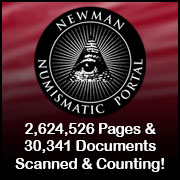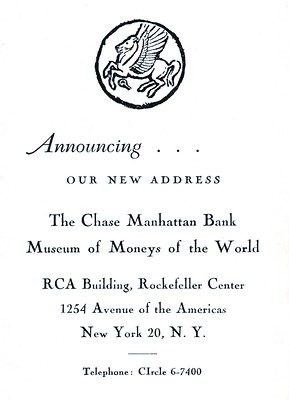
About UsThe Numismatic Bibliomania Society is a non-profit association devoted to the study and enjoyment of numismatic literature. For more information please see our web site at coinbooks.org SubscriptionsThose wishing to become new E-Sylum subscribers (or wishing to Unsubscribe) can go to the following web page link MembershipThere is a membership application available on the web site Membership Application To join, print the application and return it with your check to the address printed on the application. Print/Digital membership is $40 to addresses in the U.S., and $60 elsewhere. A digital-only membership is available for $25. For those without web access, write to: Charles Heck, Treasurer
AsylumFor Asylum mailing address changes and other membership questions, contact Chuck at this email address: treasurer@coinbooks.org SubmissionsTo submit items for publication in The E-Sylum, write to the Editor at this address: whomren@gmail.com BUY THE BOOK BEFORE THE COINSale Calendar |
- WAYNE'S WORDS: THE E-SYLUM FEBRUARY 2, 2020
- NEW BOOK: WHITE GOLD: EARLY ELECTRUM COINAGE
- NEW BOOK: MEXICO CITY MINT VARIETY GUIDE 1772-1821
- NEW BOOK: 2019 CNRS TRANSACTIONS VOLUME 6
- NEW BOOK: PAPER CURRENCY IN SOUTH-EAST SHANXI
- NEW ARTICLE: THE FORGER AND NUMISMATIST
- NEWMAN PORTAL ADDS CARNEGIE LARGE CENT IMAGES
- VIDEO: 2020 FUN SHOW OPENING CEREMONY
- REMEMBERING JAMES SKALBE
- CHASE MANHATTAN MONEY MUSEUM: IN GOD WE TRUST
- NOTES FROM E-SYLUM READERS: FEBRUARY 2, 2020
- SIR THOMAS BROWNE AND THE QUINCUNX PATTERN
- QUERY: A BLANK CIVIL WAR PAYCHECK
- NEWS FROM 7/28/1884: NJ WASHINGTON COPPER
- VOCABULARY TERM: PATINA, PART 2
- JOHNSON GIDEON BINGHAM (1845-1926)
- HARVEY STACK'S NUMISMATIC FAMILY, PART 62
- WAYNE MILLER: THE KING OF SILVER DOLLARS
- 2019 BURNETT ANDERSON AWARDEE PETER VAN ALFEN
- CALL FOR PAPERS: COINS AS SOCIAL ARTIFACTS
- PERATROVICH DOLLAR RELEASE BILL GAINS GROUND
- NUMISMATISTS OF WISCONSIN 60TH ANNIVERSARY
- STRIKE GOLD AT 2020 ATLANTA NATIONAL MONEY SHOW
- SELECTIONS FROM HOLABIRD FEBRUARY 2020 SALES
- NUMISMATIC NUGGETS: FEBRUARY 2, 2020
- LUDICA OF MERCIA COIN CONFOUNDS EXPERTS
- LATVIA HONEY COIN NAMED COIN OF THE YEAR WINNER
- STRIKE YOUR OWN OWN BREXIT 50P EVENT POPULAR
- BREXIT 50P BOYCOTT OVER OXFORD COMMA
- ROYAL MINT ALPHABET COINS A BOON FOR VISITORS
- THE CITY OF CHARLESTON FREE BADGE
- 1899 EXPOSITION PROVINCIALE AWARD MEDALS
- ECKERT'S ENIAC COMPUTER JOHN SCOTT MEDAL
- HIGHLAND MINT STRIKES SUPER BOWL LIV TOSSING COIN
- AUSTRALIA FIREFIGHTERS NATIONAL EMERGENCY MEDAL
- NUMISMATISTS EDUCATE GOVERNMENT ON COIN VALUES
- LOOSE CHANGE: FEBRUARY 2, 2020
Click here to access the complete archive
Click here to unsubscribe (scroll down)
To comment or submit articles, reply to whomren@gmail.com
Content presented in The E-Sylum is not necessarily researched or independently fact-checked, and views expressed do not necessarily represent those of the Numismatic Bibliomania Society.
WAYNE'S WORDS: THE E-SYLUM FEBRUARY 2, 2020
 New subscribers this week include: Tom Bisson, courtesy of Bob Van Arsdell; Raphael Dvir, Frederick Hodes, Roeland Krul, Alice Mathiasen, Antonio Moreno Osorio, Yuriy Pyrozhko, Mohammad
Raihan, Aleksey Tarasov, Krzysztof Wójtowicz, also Enro, Gilberto, Patrick, and Serg! Welcome aboard! We now have 6,084 subscribers.
New subscribers this week include: Tom Bisson, courtesy of Bob Van Arsdell; Raphael Dvir, Frederick Hodes, Roeland Krul, Alice Mathiasen, Antonio Moreno Osorio, Yuriy Pyrozhko, Mohammad
Raihan, Aleksey Tarasov, Krzysztof Wójtowicz, also Enro, Gilberto, Patrick, and Serg! Welcome aboard! We now have 6,084 subscribers.
Many thanks to Owen Linzmayer of The Banknote Book - many of this week's new signups came as a result of a note about The E-Sylum that he added to his web site. If you run a web
site, please consider doing the same to help get the word out. Here's what Owen posted:
Free subscription to The E-Sylum numismatic newsletter (https://banknotenews.com/?p=4251)
Thank you for reading The E-Sylum. If you enjoy it, please send me the email addresses of friends you think may enjoy it as well and I'll send them a subscription (but let me know if they are located in the European Union). Contact me at whomren@gmail.com anytime regarding your subscription, or questions, comments or suggestions about our content.
This week we open with four new books, an article, the Clapp large cent collection at Carnegie Museum, and notes from E-Sylum readers.
Other topics this week include the Chase Manhattan Money Museum, In God We Trust, Civil War paychecks, the New Jersey Washington copper, Wayne Miller, James Skalbe, Dr. Peter Van Alfen, Larry Stack, the Peratrovich dollar, the Coin of the Year awards, the Charleston Free Badge, the ENIAC computer medal, and the Super Bowl tossing coin.
To learn more about electrum coinage, the forger and the numismatist, four strongly detailed chain cents, really small coins, a numismatic mystery, Mercury Head Cabernet, patina, the French Ransom Fund medal, Silverton Scrip notes, Luther the Swine, the honey coin, the quincunx pattern, and ostrich plumage, read on. Have a great week, everyone!
Wayne Homren
Editor, The E-Sylum
NEW BOOK: WHITE GOLD: EARLY ELECTRUM COINAGE
The American Numismatic Society announced in their January 2020 E-News that the book White Gold: Studies in Early Electrum Coinage is at the printer and will be ready to ship on March 17, 2020. -Editor
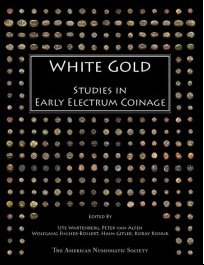 White Gold: Studies in Early Electrum Coinage
White Gold: Studies in Early Electrum Coinage
Peter Van Alfen (Editor); Ute Wartenberg(Editor); Haim Gitler; Koray Konuk
ISBN: 9780897223492
Published by: American Numismatic Society
Year of Publication: 2020
Language: English
300p
H11 x W8.5
For more information, or to order, see:
White Gold: Studies in Early Electrum Coinage [Hardback] (https://www.oxbowbooks.com/dbbc/white-gold.html)
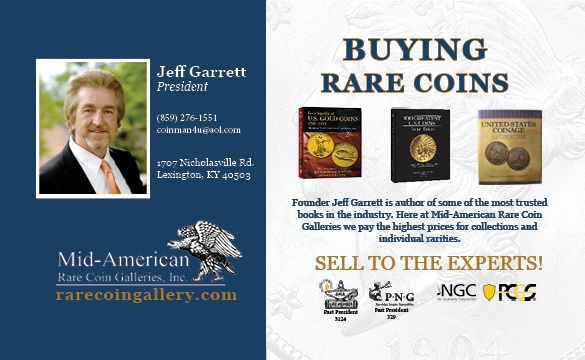
NEW BOOK: MEXICO CITY MINT VARIETY GUIDE 1772-1821
Author Brad Yonaka shared this press release for his new book on coinage of the Mexico City Mint 1772-1821. Thanks! -Wayne -Editor
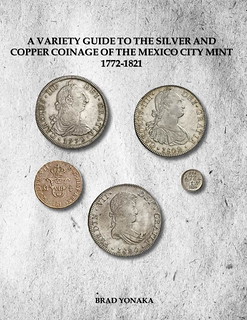 A Variety Guide to the Silver and Copper Coinage of the Mexico City Mint 1772-1821
A Variety Guide to the Silver and Copper Coinage of the Mexico City Mint 1772-1821
by Brad Yonaka
ISBN: 978-0-9986825-3-2
262 pp. | 8 ½ x 11 inch hardbound
In 1772, King Charles III’s long delayed order to change the design of Spanish colonial coinage finally went into effect. The Mexico City mint, flush with the highest influx of mined silver it had ever experienced in its long history, began striking the newly designed silver reales by the tens of millions, all now adorned with the likeness of the king. These portraits, which over time included his son Charles IV, and then his son, Ferdinand VII, oversaw the final stages of the dying Spanish American colonial edifice. The coinage of this period was welcome in every trading port of the world, yet failed even to sustain the local Mexican economy.
This book, self-published in January 2020, is a detailed variety guide for all denominations of the silver and copper reales issues from the Mexico City mint, covering the years 1772 to 1821. It is essentially a companion volume to previous offerings by the author entitled "A Variety Guide to the Fractional Pillar Coinage of Mexico City, 1732-1771" and "A Variety Guide to the Pillar Coinage of the Guatemala Bogota, Lima, Potosi, and Santiago Mints 1751-1772". As such the layout is quite similar. The targeted audience is the collector of Spanish colonial or Mexican coinage, and presumes the reader has a basic knowledge of 18 th century minting processes. It draws from a database of close to 5000 coin images gathered over a period of two years from online auctions and photographs of private collections.
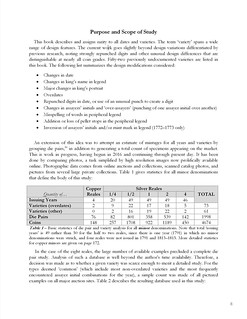
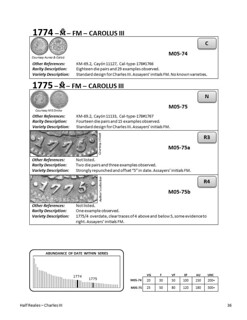
No previous publication has dealt exclusively with this coinage type, and in such detail. Fifty-two new varieties are cataloged, and some speculative variety types and dates listed but unproven in past research are refuted by lack of current evidence. With over 500 black and white photos of full coins and close-ups of variety details, this book strives to provide collectors with the most descriptive tools possible in pursuit of this famous coin type. Full cross references to previous catalog numbers (if they exist) are given for each entry.
The book also contains descriptive and historical information, estimated rarities (based on the author’s extensive auction database and comprehensive die pairing study), and pricing guide based on recent auction results.
Price: $65 + $5 shipping within USA for total of $70. Overseas shipping please inquire. Order by sending personal check to:
Agorocu Consulting Inc.
PO Box 41515
Long Beach, CA 90853
Or payment by Paypal to: acanthite@live.com
To read E-Sylum articles on Brad's earlier books, see:
NEW BOOK: MEXICO CITY FRACTIONAL PILLAR COINAGE (https://www.coinbooks.org/v20/esylum_v20n26a04.html)
NEW BOOK: THE PILLAR COINAGE (https://www.coinbooks.org/v21/esylum_v21n33a06.html)
THE BOOK BAZARRE
NEW BOOK: 2019 CNRS TRANSACTIONS VOLUME 6
Scott Douglas submitted this announcement of the availability of the latest issue of the Transactions of the Canadian Numismatic Research Society. Thanks! -Editor
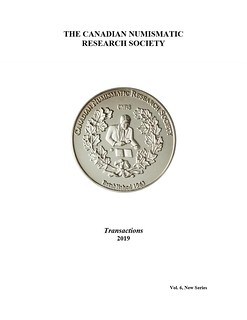 I'd like to make readers of The E-Sylum aware of the Canadian Numismatic Research Society issue of the (New Series) Transactions Volume 6 for 2019. This year the Transactions is
55 pages, card covered and perfect bound. Shortly after the orders are assembled, as in the past, the edition will be mailed and that will be that. We do not plan on holding stock. Expect delivery by
the end of February.
I'd like to make readers of The E-Sylum aware of the Canadian Numismatic Research Society issue of the (New Series) Transactions Volume 6 for 2019. This year the Transactions is
55 pages, card covered and perfect bound. Shortly after the orders are assembled, as in the past, the edition will be mailed and that will be that. We do not plan on holding stock. Expect delivery by
the end of February.
To order your copy please send a cheque, money order, PayPal or e-transfer payable to Scott Douglas for:
Canadian addresses (postpaid): $35 in Canadian funds or
United States addresses (postpaid): $35 in US funds to:
Scott Douglas
273 Mill St. East
Acton, Ontario, Canada
L7J 1J7
Questions? Email Scott Douglas – sdouglas333@gmail.com
Don't procrastinate - order now. Here's the table of contents. -Editor
A Guide for Contributors
In Memoriam – Mel Kyle by Len Buth
In Memoriam – Norm Williams by Peter Moogk
In Memoriam – Walter Allan by Susan Allan
In Memoriam – Freeman Clowery by Warren Baker
"Dollars" For The Bank.
The Origins of Silver to the Bank Of England. by William N. Clarke
A Communion Token’s Fall from Grace by Eric Leighton
Howard Laing Hutt. Professor, Gardener, and Numismatist (1866 – 1948) by Scott E Douglas
Afterword by Scott E Douglas

NEW BOOK: PAPER CURRENCY IN SOUTH-EAST SHANXI
In her Chinese Money Matters blog, Helen Wang, Curator of East Asian Money at The British Museum discussed a new book on the origin of currency in Shanxi Province. -Editor
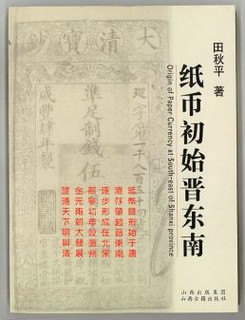 Many thanks
to TIAN Qiuping 田秋平 for giving us a copy of his book.
Many thanks
to TIAN Qiuping 田秋平 for giving us a copy of his book.
TIAN Qiuping, Zhibi chushi Jin dongnan (Shanxi guji chubanshe, 2007). ISBN 978-7-80597-856-6 // Origin of Paper Currency at South-east of Shanxi Province. TIAN Qiuping, Origin of Paper Currency at South-east of Shanxi Province (Taiyuan: Shanxi guji chubanshe, 2007). Black and white illustrations.
Brief Table of contents
Chapter 1: Tang dynasty paper money
- The concept of "paper money" in Tang times (p.3)
- The beginnings of paper money (4)
- "Flying cash" – the start of paper money (9)
- Tang dynasty money written in ink (10)
- "Great Tang TreasureCertificates" – did they exist? (14)
Chapter 2: Northern Song dynasty paper money
- The concept of paper money in the Song dynasty (19)
- Official notes (jiaozi) (20)
- The establishment of the Luzhou jiaozi office (22)
- The suspension and end of the Luzhou jiaozi office (28)
- On the printing plates for Luzhou jiaozi (29) The meaning of qian si cang (33)
- Materials relating to Luzhou jiaozi (34)
Chapter 3: Jin and Yuan dynasty paper money
- The concept of paper money in the Jin dynasty (42)
- The "Luzhou contract" notes of the Zhenyou period (43)
- Zhenyou period printing plates unearthed in Qin xian (45)
- Jin dynasty silver ingots of Licheng county (50)
- A hundred years of Yuan dynasty paper money (51)
Chapter 4: Ming dynasty paper money
- The concept of paper money in the Ming dynasty (57)
- A Chongzhen plate for Ming dynasty notes unearthed in Luzhou (59)
- The emergence of private coin-shops (qianzhuang) (66)
- The Ming dynasty notes from Luzhou and Cangu Temple (69)
Chapter 5: Qing dynasty paper money
- The concept of paper money in the Qing dynasty (77)
- The Changzhi "coin-table" (qianzhuo) (79)
- Changzhi "coin-businesses" (qianhang) in the early Qing dynasty (81)
- Tracing back to the source of "coin-notes" (qianpiao) (93)
- The proliferation of private notes (97)
- County-level notice aimed at the qianhang (104)
- Varieties of private notes and coin-notes (112)
Chapter 6: Lu[zhou] salt and salt notes
- Traces of salt-trading in ancient times (139)
- The circulation of salt notes (yanchao, yanyin) in historical times (142)
- Bi Xiang, who issued salt notes (yanchao) and Luzhou (146 )
- Some big salt traders of Luzhou (148)
- Conclusion (155)
References and sources (156)
Afterword (157)
To read the complete article, see:
65. BOOK: ORIGIN OF PAPER CURRENCY IN SOUTH-EAST SHANXI
(https://chinesemoneymatters.wordpress.com/2020/01/26/66-book-origin-of-paper-currency-in-south-east-shanxi/)
NEW ARTICLE: THE FORGER AND NUMISMATIST
Helen Wang, Curator of East Asian Money at The British Museum also discussed a new article by by Lyce Jankowski 19th century Chinese collectors and forgers. -Editor
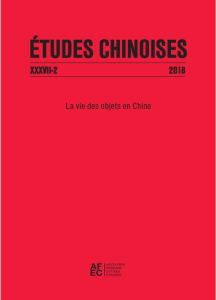 The latest edition of ÉTUDES CHINOISES – Revue de l’Association française d’études chinoises, Vol. XXXVII-2 (2018), has been published, and includes an article on Chinese numismatics by
Lyce Jankowski, curator of non-European arts at the Musée Mariemont, Belgium. It was presented at the study day she co-organised with Alice Bianchi, in Paris, in 2018, and includes abstracts
published in French, with abstracts in French, English and Chinese:
The latest edition of ÉTUDES CHINOISES – Revue de l’Association française d’études chinoises, Vol. XXXVII-2 (2018), has been published, and includes an article on Chinese numismatics by
Lyce Jankowski, curator of non-European arts at the Musée Mariemont, Belgium. It was presented at the study day she co-organised with Alice Bianchi, in Paris, in 2018, and includes abstracts
published in French, with abstracts in French, English and Chinese:
"What lengths the forgers go to! They produce items as large as yi and ding vessels; and as small as coins." These are the bitter facts that greet the reader on the first page of Guanguge quanbian (Identifying the coins from the Guanguge), a pamphlet from 1873 which deals exclusively with the question of forgeries. Written by the eminent numismatist and collector Bao Kang (1810-1881), it gives the names of several forgers of the Xianfeng and Tongzhi reign periods, and details of their particular techniques. These forgeries, aimed at collectors, circulated through the hands of antique dealers.
We learn that some dealers availed themselves of the services of forgers. For example, the brothers Su Zhaonian (dates unknown) and Su Yinian (dates unknown) in Chang’an worked together with a certain Zhang Erming (dates unknown). The manufacturing techniques varied, and some were more sophisticated than others. The simplest method was to make casts of existing coins; but sometimes an old coin might be given a new inscription, and some fantasy pieces were created too.
One forger in particular attracted great attention. He was Li Baotai ??? († ca 1875), who earned the respect of the most important collectors of the time—Liu Xihai (1793-1852), Ye Zhishen (1776-1861), Li Zuoxian (1807-1876), Chen Jieqi (1813-1884), and Yang Jizhen (1820-1901) —who called on his talents at making rubbings and entrusted him with their private collections of coins. They even bought old coins for him, although they were aware of his forgery business. The quality of his rubbings rendered him indispensable to them and at the same time afforded him direct access to rare pieces, which he could copy at leisure. The relationships between the collectors and forgers were thus ambiguous. Bao Kang frequently met with the forgers, whom he named, and whose skills he acknowledged. The sale of such forgeries did not worry him as much as the possibility that they might be published by collectors who did not know better.
To read the complete article, see:
64. "THE FORGER AND NUMISMATIST: LI BAOTAI AND BAO KANG" – BY
LYCE JANKOWSKI (https://chinesemoneymatters.wordpress.com/2020/01/25/64-the-forger-and-numismatist-li-baotai-and-bao-kang-by-lyce-jankowski/)

NEWMAN PORTAL ADDS CARNEGIE LARGE CENT IMAGES
The latest additions to the Newman Numismatic Portal are photos of the Carnegie Museum George H. Clapp Large Cent collection. Project Coordinator Len Augsburger provided the following report. Thanks. -Editor
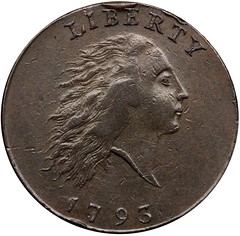
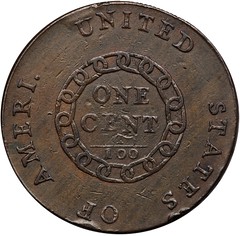
Newman Portal Adds Carnegie Museum Large Cent Collection Images
While the story of the frontline portion of the George H. Clapp large cent collection at the American Numismatic Society is well known (with many pieces switched out by William H. Sheldon and today largely recovered), few collectors realize that Clapp also donated (c. 1946-1947) nearly 500 large cent duplicates to the Carnegie Museum of Natural History in Pittsburgh, PA. These have been recently photographed by Lyle Engleson, under joint sponsorship of Newman Portal and Early American Coppers (EAC).
Although certain delicacies such as the S-48 "Starred Reverse" variety are not present here, the Carnegie holding does include four strongly detailed chain cents in addition to the rare S-80 Jefferson Head and other rarities. Engleson’s imaging is superb as always and will serve as the definitive photographic record of this collection for the foreseeable future. An exhibition of the Carnegie collection will be a highlight of the 2020 EAC convention, to be held in Pittsburgh April 30 – May 3, 2020. Newman Portal acknowledges EAC President Bill Eckberg for his coordination of this project.
Images: 1793 S-1 chain cent from the Carnegie collection
Link to Carnegie Museum / George H. Clapp U.S. large cents on Newman Portal:
https://nnp.wustl.edu/library/imagecollection/515508
Link to 2020 EAC Convention announcement, including an exhibition of the Carnegie collection, in Coin World:
https://www.coinworld.com/news/us-coins/eac-convention-highlight-visit-to-clapp-collection-of-large-cent-duplicates
VIDEO: 2020 FUN SHOW OPENING CEREMONY
These are selections from the David Lisot Video Library that feature news and personalities from the world of coin collecting. David has been attending coin conventions since 1972 and began
videotaping in 1985. The Newman Numismatic Portal now lists all David’s videos on their website at:
https://nnp.wustl.edu/library/multimediadetail/522852
Here's one on the recent FUN show opening ceremony. -Editor
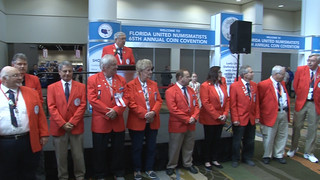 FUN Coin Convention Opening Ceremony Orlando 2020. VIDEO: 6:23.
FUN Coin Convention Opening Ceremony Orlando 2020. VIDEO: 6:23.
Bob Hurst, President, Florida United Numismatists
The annual FUN Coin Convention took place in Orlando January 9-12, 2020. President Bob Hurst welcomed attendees and introduced American Numismatic Association President Steven Ellsworth and the FUN staff who help put on the show. Then the ribbon is cut and the show opens to the public.
An excerpt of the video is available for viewing on the Coin Television YouTube Channel at:
https://youtu.be/8x4VUeBtjzg

REMEMBERING JAMES SKALBE
Colonial Coin Collectors Club (C4) Past President Ray Williams provided this remembrance of dealer James Skalbe. Thanks! -Editor
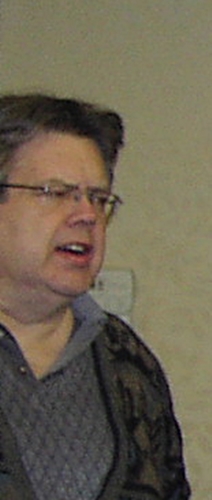 At our C4 Conventions in Boston, if you stopped at the C4 table, you would find Tom Rinaldo's table on your right and Jim Skalbe's table on the left. While breaking down the C4
table at one convention's end, a young man, pre-teen, maybe 10 years old, approached the C4 table. I always make time for young people (and old ones too). I asked him what he collected and to my
surprise, he said, "colonial coins"!
At our C4 Conventions in Boston, if you stopped at the C4 table, you would find Tom Rinaldo's table on your right and Jim Skalbe's table on the left. While breaking down the C4
table at one convention's end, a young man, pre-teen, maybe 10 years old, approached the C4 table. I always make time for young people (and old ones too). I asked him what he collected and to my
surprise, he said, "colonial coins"!
In my excitement I asked him if he brought any with him, and he replied in the affirmative. Looking at what he had, I saw a well worn Massachusetts cent and a few other coppers. Not having my readers (glasses) in reach, I handed a well worn coin I couldn't see clearly enough to Jim and asked if he could see what it was. He took about 10 seconds and replied to the young man, "I'll give you a thousand dollars for it".
"I told the young man to get his father, who was looking at a table about 20 feet away. Jim did end up with the coin. It was a Vermont Ryder 1. I'm sure there are many in C4 who could share stories about Jim. Somewhere I have a few of his old coppers he stamped with his business name. Worth little in the open market, they are of value to me.
Great story. C4 VP Craig McDonald get credit for the two images of Jim used in this article, taken from C4 publications for us by Ray Williams. Next is a remembrance from Roger Siboni. -Editor
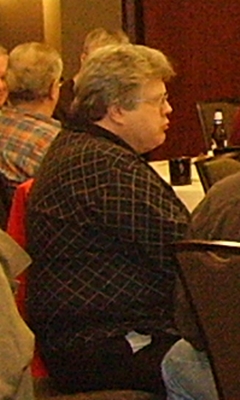 I had the good fortune to know and work with Jim Skalbe from his days at Worthy and then even more when he started Colonial Trading Company with partners (I think) Russ Smith (among others
maybe, though I only really spent time with Jim and Russ).
I had the good fortune to know and work with Jim Skalbe from his days at Worthy and then even more when he started Colonial Trading Company with partners (I think) Russ Smith (among others
maybe, though I only really spent time with Jim and Russ).
Business used to take me to Boston frequently during those days, particularly when the main Institutional Fund Managers like Fidelity where largely based there.
Jim would always manage to dig up some treasure for me about once a year. Some of my most prized possessions came from Jim.
Despite some of his excesses (see below), I always judged him by a very well known event in Colonial numismatic circles.
Then Bowers and Merena sent me three extraordinary New Jersey Coppers for lot viewing before a fairly well known sale to lot view via US Mail. I just couldn't get to the auction or live lot viewing anywhere.
They were famously lost in the mail upon my quick review and return to B&M (see C-4 Newsletter.......). Wowie!!
After supplying the necessary documentation (keep your receipts!) the insurance company and VERY quickly the FBI were on the case. Mail fraud is something the FBI takes pretty seriously!
A year later, before an ANA convention I could not make, I called Jim before the show to see what he was bringing. He sent me one coin to look at. It took a few minutes, but I don't forget too many Condition Census New Jersey coppers. A quick call revealed it walked in the door from a vest pocket dealer.
It turns out (an FBI investigation later), the vest pocket dealer bought it from a pawn shop, who bought it from an airport US Mail handler.
Jim did not hesitate an instant when I pointed him to the auction catalogue and the withdrawn three lots (all three of which were sold by the vest pocket dealer). He was on the phone with B&M in an hour to his personal loss. That was all I needed to know about Jim.
A year or two later, I was able to finally buy the three New Jersey Coppers from the insurance company!
By the same 'token' (ha ha - my vain attempt at humor), Jim lived large. Very large in every way. His girth, his personality, his love of food and drink and a great time.
We often went out to dinner in the best places in town when I was there. Often with Russ and sometimes other local collectors, dealers or friends. Colonial Trading often paid the bill and it was always a long night that I never was able to finish much after dinner.
But I will say, some great rarities like one of the finest Noe 1 Pine Tree Schilling came from Jim. Some fabulous Washington Inaugural buttons including one of the finest Pater Patrie buttons of the movie National Treasure fame came from Jim. A pristine original Stamp from the Stamp Act (go find one). I could go on. They all came from Jim.
He did live a large life, in every way. His death was always a mystery and made me sad. Jim was something for those that knew him and was one of the most knowledgable Colonial Numismatist dealers in the business.
I don't know the circumstances of his passing. Best to respect his families wishes I think. But somehow, I think Jim ended his life like he lived it. In a large way.
Thanks everyone, including Pete Smith who kicked off this discussion in an earlier issue. -Editor
To read the earlier E-Sylum article, see:
JAMES EDWARD SKALBE (1955-2017) (https://www.coinbooks.org/v23/esylum_v23n04a09.html)
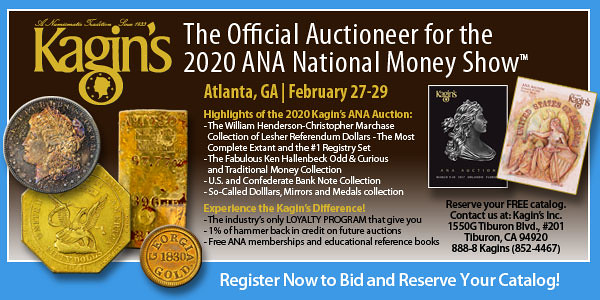
CHASE MANHATTAN MONEY MUSEUM: IN GOD WE TRUST
Ken Berger passed along these images of another Chase Manhattan Bank Money Museum pamphlet - this one on the "In God We trust" motto. Thanks! -Editor
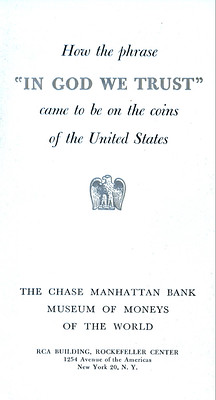
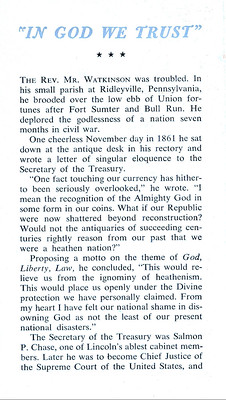
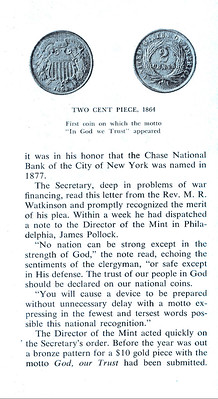
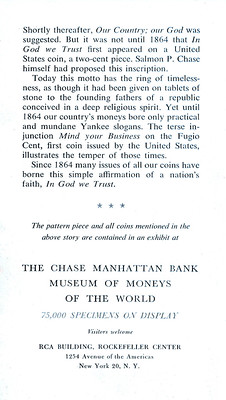
Ken also passed along this announcement card of the Museum's new address. -Editor
To read the complete article, see:
NOTES FROM E-SYLUM READERS: JANUARY 26, 2020 : Chase Manhattan Bank Money Museum Pamphlet (https://www.coinbooks.org/v23/
esylum_v23n04a14.html)

NOTES FROM E-SYLUM READERS: FEBRUARY 2, 2020
On Really Small Coins
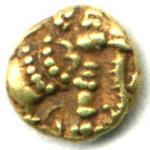
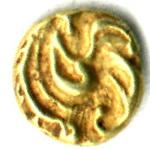
Gold Gajapati Fanam
Kavan Ratnatunga writes:
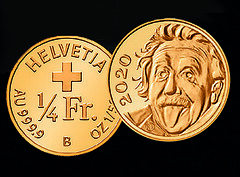 I agree the technology to put such detail in a mass-produced coin which is just 3 mm in diameter is great. Maybe the R&D & Marketing cost US$200,000, which justifies the Swiss Mint
charging 999 coin collectors US$205 for US$3 worth of Gold & Packaging. A previous record holder over 600 years old is shown in
I agree the technology to put such detail in a mass-produced coin which is just 3 mm in diameter is great. Maybe the R&D & Marketing cost US$200,000, which justifies the Swiss Mint
charging 999 coin collectors US$205 for US$3 worth of Gold & Packaging. A previous record holder over 600 years old is shown in
http://coins.lakdiva.org/medievalindian/
gajapati_fanam_au.html
The 1/10th Fanam Gold coin called Bele with a size around 2-4 mm and weight around 0.04 grams is also smaller than the modern Swiss coin.
https://www.worthpoint.com/worthopedia/indian-state-gold-coin-10th-century-440148721
Thanks. Neat little coin. -Editor
Ken Berger adds:
I was already familiar with the famous picture of Einstein sticking out his tongue. I often wondered at whom he was sticking it out. Now I know! Since it occurred on March 14, 1951, he was sticking it out at me because that is the day I was born. I guess he didn't like me.
To read the earlier E-Sylum article, see:
SWISS MINT SELLS OUT OF SMALLEST COIN (https://www.coinbooks.org/v23/esylum_v23n04a26.html)
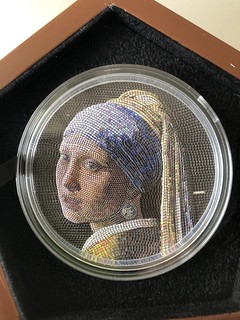 Micromosaic Passion Coin: The Girl with a Pearl Earring
Micromosaic Passion Coin: The Girl with a Pearl Earring
Lou Golino writes:
I received my third Great Micromosaic Passion coin last week (The Girl with a Pearl Earring). It is really outstanding.
Very nice! -Editor
To read the earlier E-Sylum articles, see:
MICROMOSAIC COINS: GIRL WITH A PEARL EARRING (https://www.coinbooks.org/v23/esylum_v23n02a27.html)
NOTES FROM E-SYLUM READERS: JANUARY 19, 2020 : The Micromosaic Passion Coins
(https://www.coinbooks.org/v23/esylum_v23n03a10.html)
Photo Captions with Ken Bressett
Ken Bressett writes:
"I can’t be entirely sure of everybody in the Smithsonian photo, but I easily recognize the Stefanellis. I am pretty sure that is Hans Schulman at the far left. The person seated across from Mrs. S is definitely not Abe Kosoff."
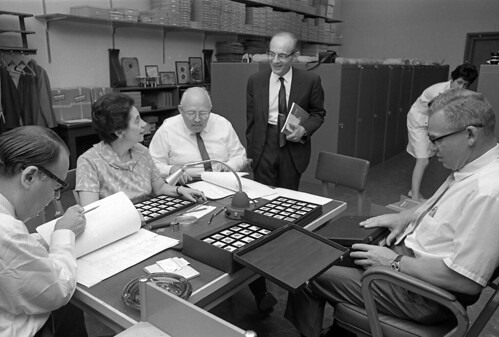
Ken adds:
"In the article about Don Hirschhorn, Dave Lange has asked for a photo of him at a younger age. This one shows Don on the right and R. S. Yeoman on the left."
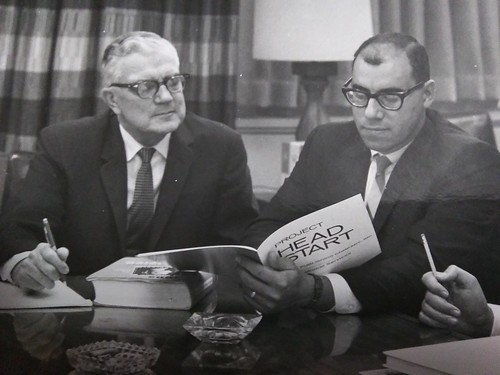
R. S. Yeoman and Don Hirschhorn
Thanks! Great photo. -Editor
To read the earlier E-Sylum articles, see:
THE CLAIN-STEFANELLIS AT THE SMITHSONIAN (https://www.coinbooks.org/v23/esylum_v23n04a15.html)
DONALD S. HIRSCHHORN (1927-2020) (https://www.coinbooks.org/v23/esylum_v23n04a08.html)
A Numismatic Storefront in 1915
Len Augsburger writes:
Illustrated here is the storefront of Burdette G. Johnson’s St. Louis Stamp & Coin Co. in 1915, taken from the December issue of Philatelic West for that year. Johnson, operating at 115 N. 11th Street in St. Louis, frequently advertised stamps, coins, and other collectibles in the pages of Philatelic West. The image is grainy, but conveys the essential information. The downtown city lot is narrow, with a large display window and a door to the side. An awning provides some protection against the elements when entering or exiting. We can only speculate what was on display, but it was likely some combination of coins and stamps with a few other objects mixed in.
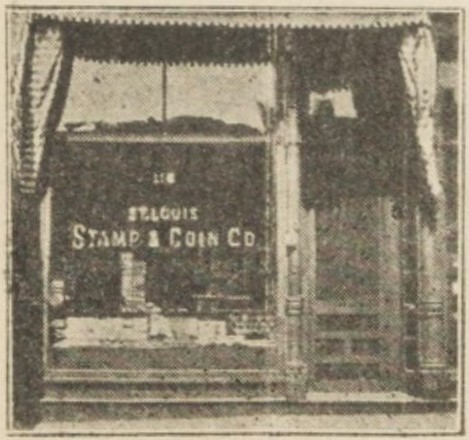
Thanks. Next-best thing to a time machine. It would be fun to explore the stock of a dealer from a century ago, without a slab in sight. Handle those coins carefully, though! -Editor
Quiz: A Numismatic Mystery
Pete Smith offers this numismatic mystery. He writes:
Who is the man pictured on the right and what is his role in current numismatics?
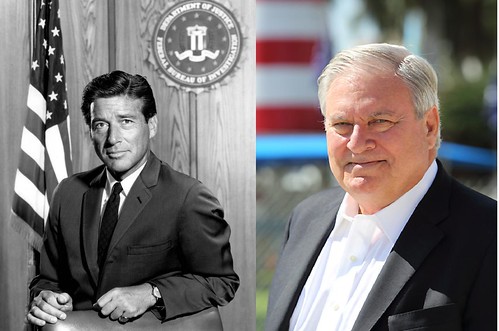
OK, E-Sylumites. Who's got the answer? -Editor
ANA Summer Seminar Medals Survey Class
David Menchell writes:
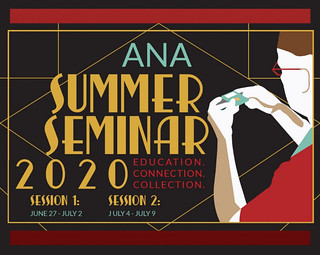 "I thought some readers might be interested in this year's ANA Summer Seminar and the class I will be teaching with David Alexander. We will be reprising the Survey class covering
medals from the early portrait medals of the Renaissance to contemporary medals issued in the 21st century. The course will cover technical aspects of producing medals, important references and
literature. and an historical survey encompassing major periods, styles, countries and important artists and engravers. The course will include much new material added since the last survey course in
2016. More information can be found on the ANA website."
"I thought some readers might be interested in this year's ANA Summer Seminar and the class I will be teaching with David Alexander. We will be reprising the Survey class covering
medals from the early portrait medals of the Renaissance to contemporary medals issued in the 21st century. The course will cover technical aspects of producing medals, important references and
literature. and an historical survey encompassing major periods, styles, countries and important artists and engravers. The course will include much new material added since the last survey course in
2016. More information can be found on the ANA website."
Sounds like a great event. The Summer Seminar is far and away one of the best things in numismatics anywhere. -Editor
For more information, or to register, see:
ANA SUMMER SEMINAR 2020 (https://www.money.org/summer-seminar)
Mercury Head Cabernet
In his Northeast Numismatics blog this week, Chris Clements writes:
Check out this find at a wine store near me this past weekend. Mercury Head Cabernet. Really high star rating, but also really expensive. I couldn't help myself and had to buy it. (Then explain to my wife when I brought it home that this nice wine is NOT for drinking!)
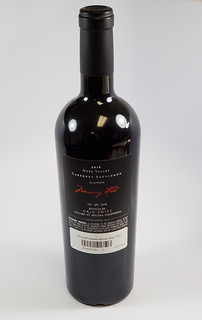
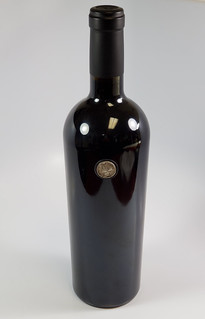
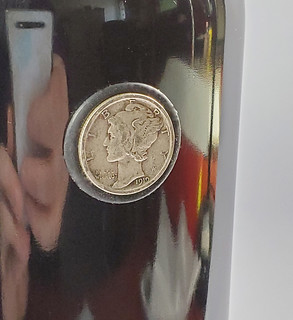
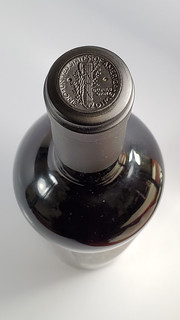
Very nice! I'll look for this. -Editor
To read the complete article, see:
Northeast's Blog (https://www.northeastcoin.com/blog.jsp)

SIR THOMAS BROWNE AND THE QUINCUNX PATTERN
Last week's essay on the books of Sir Thomas Browne inspired Bob Van Arsdell to submit these thoughts on Browne and the quincunx pattern as a design element in coinage. Thanks. -Editor
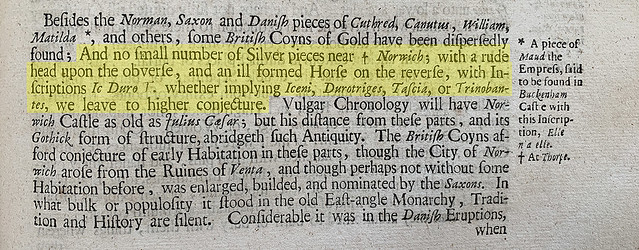
I've known for some time that Sir Thomas Browne had a loyal following of enthusiasts, but I never imagined there would be more than one of us on The E-Sylum. I wonder how many others there are? I'd like to think that his Pseudodoxia Epidemica entitles him to the title: "Father of the Mythbusters".
Browne has some numismatic connections worth noting. In the Hydriotaphia, he used finds of Roman coins to date archaeological sites in Britain. He's usually credited with the earliest report of the Cani Duro type of Celtic Coin as well (though the coin he reported didn't carry the full legend).
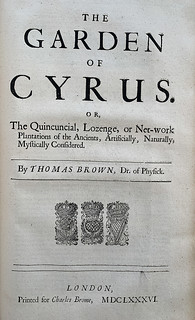
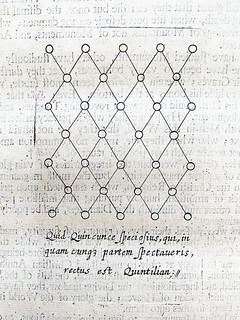
His Garden of Cyrus never receives the attention it deserves. He pointed out the "quincunx pattern" (a checkerboard of diamonds) as something the human mind was attracted to – something that influences the way people think and and act. He shows how the pattern was used over and over in ancient times. Workers today would recognize this as one of the earliest uses of "Structural Analysis" in archaeology, pre-dating Levi-Strauss by 300 years.
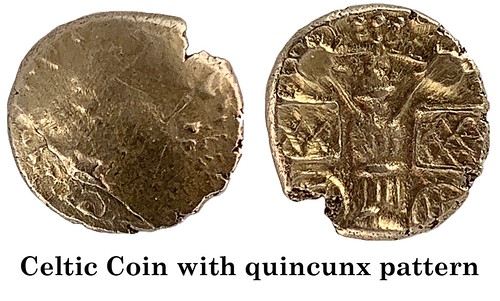
Ancient British coins occasionally show the quincunx as an image element – as on this Kentish gold quarter stater struck about 45-40 BC. The reverse image is adapted from a Roman Denarius of Julius Caesar showing a "trophy of arms". The Celtic die-cutter has loaded the field with boxes and circles filled with quincunx patterns, something not seen on the Roman prototype. This would be a case where numismatists might employ Structural Analysis to study the image and its meaning – and use the idea introduced 350 years ago by Sir Thomas Brown.
To read the complete article, see:
ESSAY: RARE NECESSITIES (https://www.coinbooks.org/v23/esylum_v23n04a07.html)

QUERY: A BLANK CIVIL WAR PAYCHECK
Michael Atkins writes:Below is what I think is a blank Civil War Paycheck from 1862, a lithograph from Hatch & Co. I have searched past Heritage auctions, Newman Portal, and various search engines. The best I’ve been able to do is several photos of filled out and endorsed CW paychecks, but nothing like this. JJ Cisco would have been Assistant US Treasurer for New York so it would probably have come out of his office. Anyone know more about this?
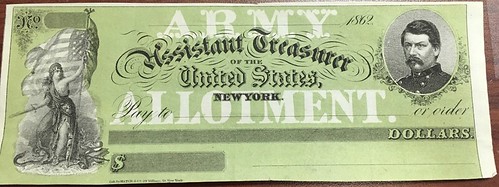
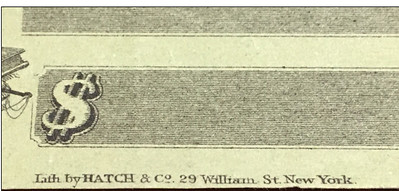
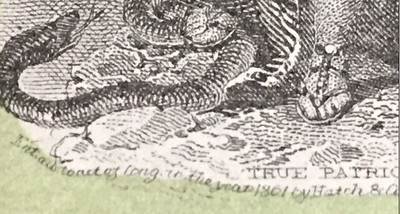
I can think of a few federal contractors who would be happy to have a blank check from Uncle Sam. In the paper money world, unissued remainders are sought after for their generally high condition yet are often far more common than issued examples. With checks it can sometimes be the opposite. Issued and cancelled checks have no monetary value and often come into the collectible marketplace years later when offices and files get cleaned out. Blank checks are guarded more carefully while the accounts they draw on are still open. But years later, if not destroyed, unissued checks can enter the market as well.
Can anyone add anything about this unissued check? Do other examples exist? -Editor
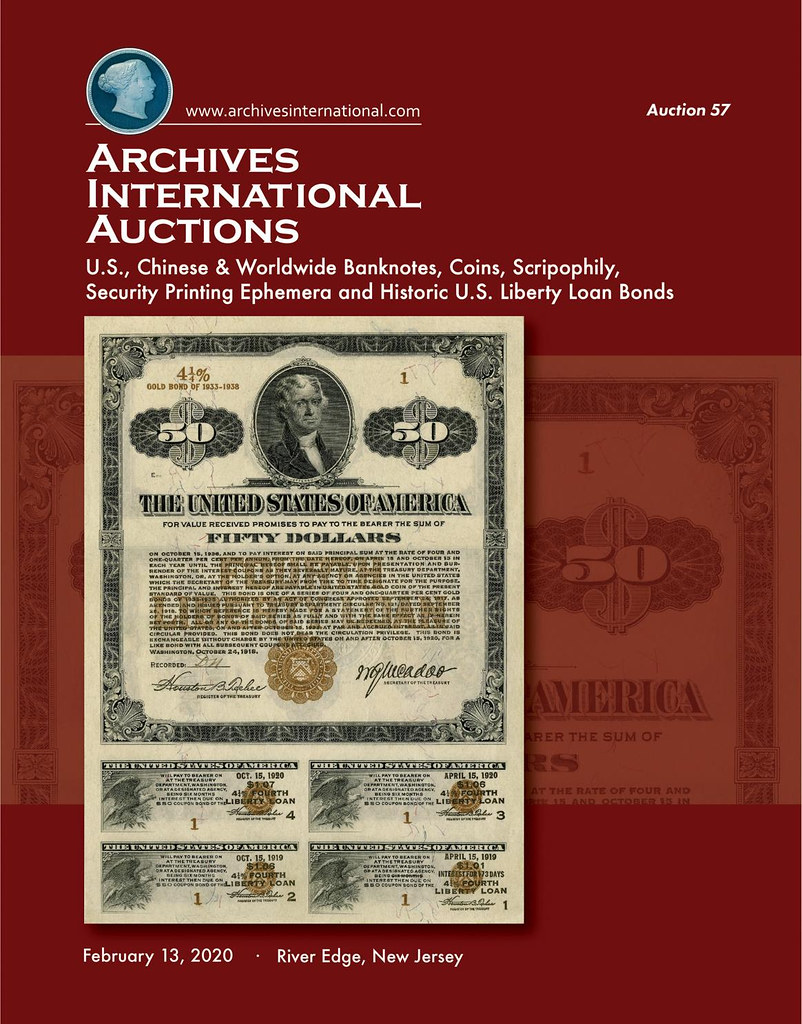
NEWS FROM 7/28/1884: NJ WASHINGTON COPPER
I've always enjoyed old newspaper articles relating to numismatics - there is a large world of interesting and often overlooked information waiting to be discovered (or rediscovered) by today's collectors and researchers. For some time now I've wanted to have a regular E-Sylum article featuring these delightful snippets - even ones that are laughably incorrect.
Researcher and longtime E-Sylum contributor Julia Casey offered to kick off such a series. Here is her first contribution, on the rare "New Jersey Washington" Copper. Readers are welcome to send in their own contributions - we'd love to hear from you. -Editor
In the January 1874 edition of the American Journal of Numismatics, William Sumner Appleton published an article titled "Newspaper Cuttings." He explained he was inspired to do so as "A VERY curious if not valuable paper might be made up from the many little items concerning numismatics which have appeared in the newspapers of late years. I propose to try something of the kind, to preserve in the Journal various facts, which have never yet been printed there."
In furtherance of this noble enterprise, below is a numismatics-related newspaper article that appeared in the July 28, 1884 edition of The Times (Philadelphia).
Haseltine on the "New Jersey Washington" Copper
John W. Haseltine, the antiquary and numismatist, tells a curious story of his accidental discovery of the General Washington penny of New Jersey. "One day an old man, a total stranger to me," said Mr. Haseltine, "came into my place with a number of old copper coins he wished to sell. After a little discussion in regard to the price I bought the lot, which seemed to consist altogether of trash, at the rate of about two cents apiece. They were dirty and in very poor condition. After they had been washed and the acids applied I discovered this one, the only one of its kind, to my knowledge, in existence. Dr. Maris came in to see me a few days after this and I offered him the coin for forty dollars. He refused to give more than thirty, and when he came back the next day to give me my own price for it I told him I had been thinking all night about that penny and it shouldn’t go for less than a hundred. This made him angry and he went away. I sold it in New York two weeks afterwards for $150. This was eight years ago. After the man who bought it died his collection was sold at auction and the coin passed into the hands of L.G. Parmalee, of Boston, who paid $610 for it. This gentleman possesses the finest cabinet of coins in the United State. It contains more unique specimens than half a dozen other cabinets put together and must have cost him not less than $50,000. A hundred thousand dollars couldn’t buy it."
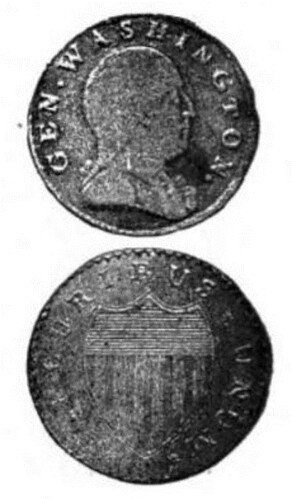 Some History Behind the Article:
Some History Behind the Article:
The "General Washington penny of New Jersey" is pictured in Neil Musante’s Medallic Washington on page 11 and indexed as GW-04. Per Musante, quoting Baker: "This piece, found in a lot of old coppers about ten years ago, by Mr. John W. Haseltine, of Philadelphia, was purchased at the Crosby sale, June, 1883, by Lorin G. Parmelee, of Boston, for six hundred and twenty dollars, the highest price as yet paid for any single Washington piece. The date is probably 1786."
This coin is more commonly known as the "New Jersey Washington Cent" and has been attributed to Walter Mould, who was also involved in the minting of New Jersey coppers. Musante indicates there are presently "3 known." Haseltine’s example is shown in the 1908 article:
The coin imaged by Musante is from the collection of Syd Martin and is a different coin than Haseltine’s (notably it has sharper detail and has been holed):
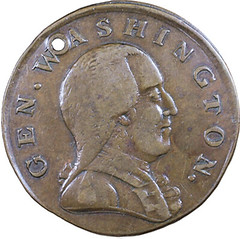
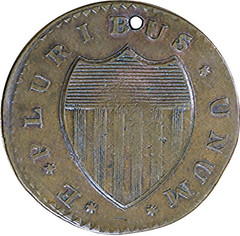
Haseltine told his story again at the 1908 A.N.A. Convention (published in the October-November 1908 edition of The Numismatist). It is this reiteration, rather than the 1884 newspaper article, which appears to be the source for the standard history of the coin. However, some details are different from what was reported in 1884:
The unique New Jersey Washington cent was brought into my store in a bag with about one thousand other copper pieces covered with grease and dirt. They were accumulated in a small grocery store kept by an old woman who was so suspicious that she would not get what they were worth that every coin I looked at carefully she quietly slipped in her pocket after I laid it down. Realizing at that rate I would get nothing examined, I merely counted them - (noticing the New Jersey cent but not daring to examine it to see if it was copper or lead) and as most of the pieces were common United States Colonials and foreign coins I obtained them at two cents each. After she left the store I hastily looked over them until I found the New Jersey Washington and ascertained it was a struck piece in copper. I offered it to Dr Maris of this city for fifty dollars, he declined to purchase, saying the price was too high. Realizing after research that I had a unique coin I then sold it to Mr. S.S. Crosby of Boston for one hundred and fifty dollars. You probably know of its history since, and that no other has ever been discovered. It would probably sell now for about fifteen hundred dollars.
It should be noted that in the 1884 article Haseltine does not mention Crosby by name but states that "After the man who bought it died his collection was sold at auction and the coin passed into the hands of L.G. Parmalee, of Boston, who paid $610 for it." Sylvester Crosby’s collection was cataloged by Haseltine and auctioned in 1883. The New Jersey Washington Cent sold as lot 1165. However, Crosby did not die until 1914.
A January 27, 1951 letter from John Ford to Eric Newman archived on the Newman Numismatic Portal traces what Ford believed to be the 3 known examples. Haseltine’s coin is said at that time to be
in the Garrett collection at Princeton University, the Martin coin is traced to the 1914 Parsons sale, and the third specimen is from the James Ten Eyck Collection in 1922 and was owned by F.C.C.
Boyd in 1951. Ford admits some confusion over the provenance of the Haseltine coin and the Ten Eyck coin. His letter can be found here:
https://archive.org/details/fordjohnj1950to51epncorr/page/n3/mode/2up
Do any E-Sylum readers have information on the whereabouts of the Haseltine and Ten Eyck coins?

VOCABULARY TERM: PATINA, PART 2
Dick Johnson submitted this entry from his Encyclopedia of Coin and Medal Terminology. It's the second of two parts on an important numismatic topic - patina. Thanks. -Editor
Patina.
How To Further Beautify A Patina
Add an enamel.
Add a second patina color.
Do both sides in a different color.
Add a colorful object to the surface.
Add a stipple color effect (with spots of color).
Use masks and make in three or more patina colors.
Add a highlight with a contrasting color.
Add color with a tint lacquer.
Add a clear overcolor.
Add an undercolor.
Patina chemicals. The following chemicals are some of the more frequently used in patina finishes:
Ammonium carbonate (NH4)2 CO3.H2O. A mixture of ammonium bicarbonate and carbonate. Used for a bronze patina of bluish-green color. Also called "hartshorn."
Ammonium chloride (NH4Cl) A patina solution for coloring bronze a verde antique green. Also called "sal ammoniac."
Ammonium sulfide (NH4)2SO4 An excellent darkening agent for bronze and silver in highlighting during a finishing operation. The objects to be darkened are immersed in this chemical for less than ten seconds – the sulfide is the source of sulfur as the darkening agent. Also called "sulfate of ammonia" and "sulphuret of ammonia."
Barium sulfide (BaSO4) Used as a coloring agent for bronze medals for a light brown color, called "Old English."
Copper chloride (CuCl2) A patina coloring chemical producing yellowish-green color on bronze. Also called "cupric chloride."
Copper nitrate (CuNO3) Used for dark blue and green patina coloring on bronze. Also called "cupric nitrate"
Copper sulfate (CuSO4) Colors bronze green. It is the green corrosion on copper items in an atmosphere exposed to sulphur and moisture over long time. The composition of incrusted patina.
Ferric nitrate (Fe(NO3)2) For use only by very experienced finishers; colors a dark chocolate color. Care must be used, however, as some of the nitrate salts can spot the surface.
Liver sulfide (K2S) Used for a bronze patina on statues and medals; it produces a color from red brown to dark brown. Also called "liver of sulfur," "potassium sulfide," "sulfurated potash." Liquid sulfur. (S) Quickly turns bronze and silver a dull black.
Oil of lavender. A bronze patina of pale ashen green color, formed by adding yellow pigments to oil of lavender.
Potassium nitrate (KNO3) is a patina solution for turning bronze a dark red color. It is most used for tempering tool steel (heat treating dies) and for chemical analysis. It is also called "saltpeter."
Potassium permanganate (KMnO4)
History and cataloging. Bronze statues have been given protective finishes for centuries; often with patinas that are a distinctive color. But it is only since the 1880s that bronze medals have been given patinas for their distinctive color. The French were the first to develop patinas for art medals. This came about from the introduction of sandblasting a metal surface, then oxidizing and relieving this surface (known as french antique). To carry this one step further by using sculptural patinas to medals was a natural progression.
In cataloging work, medals with a color patina should be so identified. This has been observed in the past but only a rudimentary way, as the basic color of the metal finish. It is hoped that color standards can be established within the medallic field in the future and these utilized in cataloging art medals.
Patina terminology. Most patinas are named for the end color the formulas and applications produce. Even thought this technology is more than a century old it is still evolving in its terminology. An extensive word list including patina terms are given in the entry finish and finishing.
The dictionary plural of patina is patinae, but modern workers say patinas. Both are correct. Also the verb is patinate, and past tense is patinated. The noun form of an existing metal coloration is either patina or patination. To do over a patina is repatinate.
References:
T1 {1878} Spon.
T2 {1892} Hiorns.
T3 {1904} Austen.
T4 {1907} Hiscox.
T6 {1925} Field and Bonney.
T7 {1962} Fishlock.
T11 {1983} Hughes and Rowe.
T12 {1985} Brachert.
O37 {1977} Julian, pp xxxv-xxxvii.
Looking for the meaning of a numismatic word, or the description of a term? Try the Newman Numismatic Portal's Numismatic Dictionary at: https://nnp.wustl.edu/library/dictionary
Or if you would like a printed copy of the complete Encyclopedia, it is available. There are 1,854 terms, on 678 pages, in The Encyclopedia of Coin and Medal Technology. Even running two a week would require more than 19 years to publish them all. If you would like an advance draft of this vital reference work it may be obtained from the author for your check of $50 sent postpaid. Dick Johnson, 139 Thompson Drive, Torrington, CT 06790.

JOHNSON GIDEON BINGHAM (1845-1926)
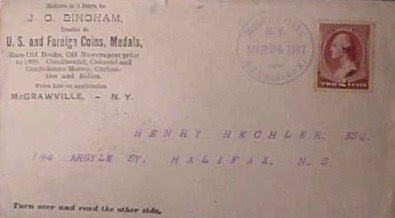 Johnson "John" Gideon Bingham (1845-1926), A farmer, town supervisor, and coin dealer who lived at Solon, with a mailing address of McGraw (McGrawville), Cortland County, New York. He was
born on June 21, 1845, the son of farmers, Samuel (1806-1891) and Sally Randall Bingham (1808-1890). His family is directly descended from Judge Johnson Bingham (1764-1843), a Revolutionary War
soldier who lived in Shaftsbury, Vermont; and in January 1794 removed to Solon, Cortland County, New York. Judge Johnson Bingham is the son of Gideon Bingham (1714-1796) of Canterbury, Connecticut,
for whom Johnson Gideon Bingham, the subject of our sketch has received his middle name.
Johnson "John" Gideon Bingham (1845-1926), A farmer, town supervisor, and coin dealer who lived at Solon, with a mailing address of McGraw (McGrawville), Cortland County, New York. He was
born on June 21, 1845, the son of farmers, Samuel (1806-1891) and Sally Randall Bingham (1808-1890). His family is directly descended from Judge Johnson Bingham (1764-1843), a Revolutionary War
soldier who lived in Shaftsbury, Vermont; and in January 1794 removed to Solon, Cortland County, New York. Judge Johnson Bingham is the son of Gideon Bingham (1714-1796) of Canterbury, Connecticut,
for whom Johnson Gideon Bingham, the subject of our sketch has received his middle name.
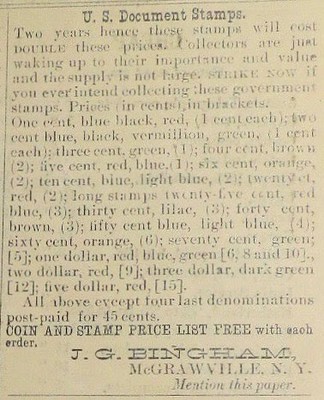 Gideon Bingham was a direct descendant of Samuel Bingham who came from England in 1686. Judge Johnson Bingham planted the first apple orchard in Cortland County on his 550-acre farm. His
grandson Johnson G. Bingham, kept his grandfather Johnson’s rifle and sword from the Revolutionary War as relics and family heirlooms. The nostalgia of his colonial family together with other various
heirlooms he inherited stimulated Bingham to become a collector and dealer in coins and other antiquities.
Gideon Bingham was a direct descendant of Samuel Bingham who came from England in 1686. Judge Johnson Bingham planted the first apple orchard in Cortland County on his 550-acre farm. His
grandson Johnson G. Bingham, kept his grandfather Johnson’s rifle and sword from the Revolutionary War as relics and family heirlooms. The nostalgia of his colonial family together with other various
heirlooms he inherited stimulated Bingham to become a collector and dealer in coins and other antiquities.
On November 21, 1872, he married Mariah W. Kinney (1851-1928) and they had a daughter, Maud Charlotte (1876-1968).
His daughter Maud became a coin dealer like her father.
Johnson Gideon Bingham, is ANA member No. 42 (revised numbering). He was a Mason of the Blue Lodge, Chapter and Commandary.

Chapman Mailer return reply postal card sent by Bingham postmarked July 7, 1907, McGraw, N.Y.
He was a collector and dealer of U. S. and ancient coins and colonial, confederate and fractional currency, and curiosities since 1860, as well as later on about 1880 as a numismatic writer. He took a trip with wife and family to California in November 1884 and a notice of this was published by Ebenezer Locke Mason, Jr. in Mason's Coin and Stamp Collectors' Magazine.
He died April 28, 1926. He is buried in Mount Olivet Cemetery, Halifax, Nova Scotia, Canada.
To read the complete article, see:
BINGHAM, JOHN GIDEON
(https://sites.google.com/a/numismaticmall.com/www/numismaticmall-com/bingham-john-gideon)
HARVEY STACK'S NUMISMATIC FAMILY, PART 62
The latest article in Harvey Stack's blog series is about the year 1973, when Larry Stack joined the firm fulltime after college. Thanks, Harvey! -Editor
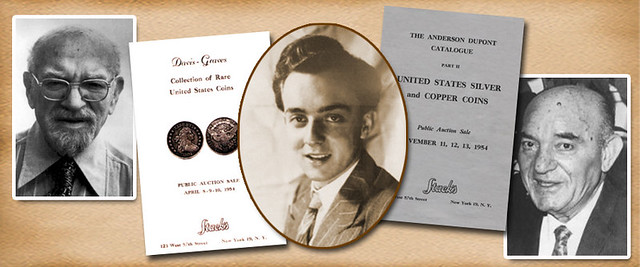
In Spring 1973, Lawrence R. Stack (Larry), graduated from Ohio University in Akron, Ohio. He majored in History and Finance, both subjects that were very beneficial to his joining the numismatic business. Larry is the son of Harvey, the nephew of Joseph, and the cousin of both Ben and Norman. This brought the number of Stack family members working in the business back to five, a number we hadn’t had since my father Morton’s death in 1967. As was true of all of us, Larry had spent his earlier days, from public school through his university years, helping at the shop when time permitted. He worked first as an apprentice, and then as a full time numismatist at Stack's. He learned how to grade coins, buy and sell, and deal with clients. He joined the firm with the benefit of already meeting and becoming friends with many of the senior collectors who would visit the shop. He was taught by the specialized staff that Stack’s maintained and learned quickly. He became well respected as a professional numismatist within a year of two of becoming "full time."
Besides working in the shop and helping with many other facets of the business, Larry concentrated on collecting. He built an expanded type set of United States coins, modeled after the prize-winning set that Norman had developed and wrote a definitive book on. Larry also focused on specialized collections of Renaissance gold and silver, ancient gold and silver coins in the Greek and Roman series, and a comprehensive collection of English gold and silver. When each was near completion, he sold at them at auction, using the funds to expand his other collections. For him, building the collections was a learning exercise that he enjoyed. Not only did he develop love for each specialized collection, but he also became friendly with those who shared that interest. He always advocated and adhered to the policy, "Read the book before you start collecting." Larry’s career as a numismatist continues to this day, and he is a founder (along with myself and Dave Bowers) of Stack’s Bowers Galleries.
Stack’s also offered a series of great auctions in 1973, several of which are remembered today as important pedigree sales. Here I list the highlight sales, and some of their features.
In early March we offered the Nate Smith Collection of around 1,879 lots, which featured a comprehensive date and mint collection for general collectors. Later in March we presented a comprehensive collection of colonial and federal coinage going back to the early days of our country. These were consigned by the Massachusetts Historical Society which was dispersing parts of the legendary Adams Family Collection. That cabinet had numerous coins that the family assembled as they pursued their political and legislative lives. Our March 1973 offering featured just over 1,200 lots. In May we offered the renowned C.H. Patten Collection of hundreds of U.S. half dollars beginning with 1794 as well as other series of popular interest. This sale had some 1,065 lots, in various grades and rarity.
In August, we had the privilege of presenting one of the most famous name collections of that era, the renowned collection of Reed Hawn. A few decades earlier, Mr. Hawn had come from his home in Texas, with his father, to visit Stack’s to begin to build a super quality collection. The years he was assembling his collection happened to coincide with many famous old time holdings being sold. Though he had minor coins in both Proof and Mint State, the highlight of his collection was the fantastic array half dollars, including early Proof issues and highlights from 1794 to 1947 either in Proof or outstanding Mint State grades. To list them all would be lengthy, but I mention here some of the outstanding rarities:
1794 through 1807: basically Mint State and included 1795, three different Varieties, 1796 15 and 16 Star, 1797, 1801
1807 through 1836: a large group of varieties which all were Mint State, choice, with some Proofs or first strikes.
1836 to 1947: virtually complete, highlighted by 1838-O in Proof, 1847/6, a run from 1850 to 1857 in Proof, along with an 1853-O in Presentation Proof grade.
He also had all of the later dates in Mint State and Proof, including the 1878-S in Gem condition. It was really an unrivaled collection. The entire offering embraced some 808 lots, and was one of the most popular collections offered that year.
In late November 1973 another major collection of United States gold, silver and copper coins was awarded to Stack’s, the property of George Scanlon. George was a fierce competitor in many of our earlier sales. He would sit in the back of the auction room and bid strongly on many of the choice and rare coins we offered for sale. George was a client for over a half a century, and originally started his collection with his grandchildren involved. But when the children grew up and did not fully embrace collecting, George decided to sell his massive collection. The sale contained some 2,797 lots of individual coins and sets, especially pre-1915 silver and copper Proof sets and full runs of all series mostly in Mint State and Proof.
The Hawn and Scanlon collections, together with three other general collections also that also sold that year (including a major offering of Greek and Roman coinage), the firm had a wonderful year of activity and the honor of serving many clients.
To read the complete article, see:
Harvey Stack Remembers: Growing up in a Numismatic Family, Part 62
(https://www.stacksbowers.com/News/Pages/Blogs.aspx?ArticleID=Harvey-Stack-Remembers-Part-62)
To read the earlier E-Sylum article, see:
HARVEY STACK'S NUMISMATIC FAMILY, PART 61 (https://www.coinbooks.org/v23/esylum_v23n03a17.html)
THE BOOK BAZARRE
WAYNE MILLER: THE KING OF SILVER DOLLARS
On the CDN Publishing site is a nice article about silver dollar author Wayne Miller. Here's an excerpt - see the complete article online. -Editor
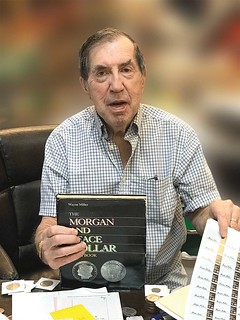 A 78-year-old coin dealer who has lived in relative obscurity in Montana most of his life wrote two books that transformed silver dollars from pretty but unpopular coins to collectibles of
major importance. Wayne Miller has not sought much attention since he wrote his two seminal works on silver dollars 40 years go. Yet many numismatists know he advanced knowledge about silver dollars
and coin collecting in general by light years. These works are An Analysis of Morgan And Peace Dollars, published in 1976, and The Morgan And Peace Dollar Textbook, released in 1982.
A 78-year-old coin dealer who has lived in relative obscurity in Montana most of his life wrote two books that transformed silver dollars from pretty but unpopular coins to collectibles of
major importance. Wayne Miller has not sought much attention since he wrote his two seminal works on silver dollars 40 years go. Yet many numismatists know he advanced knowledge about silver dollars
and coin collecting in general by light years. These works are An Analysis of Morgan And Peace Dollars, published in 1976, and The Morgan And Peace Dollar Textbook, released in 1982.
"A lot of what we know and take for granted today is due to Miller’s research and writing decades ago," said prominent numismatist Mark Salzberg, whose third-party grading service company, Numismatic Guaranty Corporation (NGC), is paying tribute to Miller with a special certification label hand-signed by the legendary researcher, author and dealer.
"Wayne Miller’s book was instrumental in my early development as a collector," Salzberg said. "I was very taken by the whole Morgan Dollar series, and his book was like a blueprint for collecting them."
Miller started in the coin business in 1966, assembling proof sets and buying silver certificates to trade for silver. But he soon gravitated to silver dollars because they were plentiful, beautiful and popular. Another Montana coin dealer, John B. Love of the Record Coin Shop in Cut Bank, was the biggest silver dollar dealer. Miller visited his shop every month or so to go through Love’s accumulation of the coins.
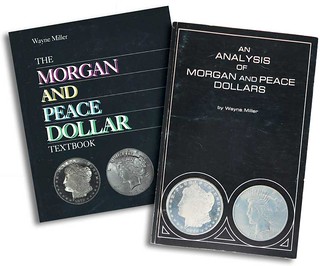 Love was, like many professional numismatists, extremely knowledgeable. But he wasn’t interested in writing, Miller said. By the early 1970s, however, Miller realized interest in the silver
dollar market was heating up and he had enough information to fill a book—literally. Plus, he felt like he needed to do something to elevate his status from a small-time silver dollar dealer among
many. "I knew I had to do something to put myself on another level." Miller modestly points to Love’s contributions to the silver dollar market, but many people refer to Miller as the "King of Silver
Dollars" because of his leading role in promoting a wider appreciation for their beauty and variety. Miller said he was glad his first book raised his profile enough that Love would partner with
him.
Love was, like many professional numismatists, extremely knowledgeable. But he wasn’t interested in writing, Miller said. By the early 1970s, however, Miller realized interest in the silver
dollar market was heating up and he had enough information to fill a book—literally. Plus, he felt like he needed to do something to elevate his status from a small-time silver dollar dealer among
many. "I knew I had to do something to put myself on another level." Miller modestly points to Love’s contributions to the silver dollar market, but many people refer to Miller as the "King of Silver
Dollars" because of his leading role in promoting a wider appreciation for their beauty and variety. Miller said he was glad his first book raised his profile enough that Love would partner with
him.
To read the complete article, see:
Wayne Miller: The King of Silver Dollars
(https://www.greysheet.com/news/story?title=wayne-miller-the-king-of-silver-dollars)
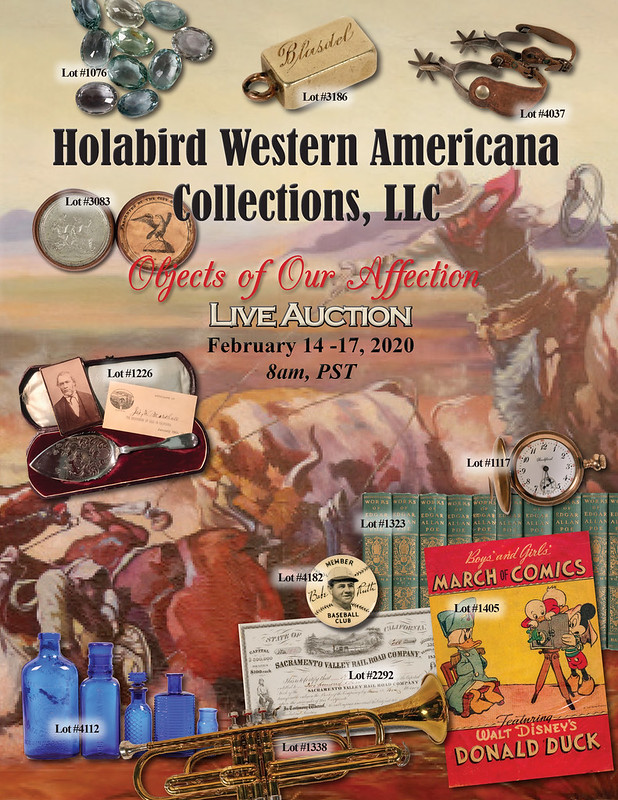
2019 BURNETT ANDERSON AWARDEE PETER VAN ALFEN
Dr. Peter van Alfen of the American Numismatic Society has been named the winner of the 2019 Burnett Anderson Memorial Award. Congratulations! -Editor
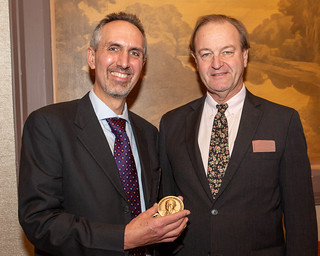 Dr. Peter van Alfen is awarded the 2019 Burnett Anderson Memorial Award for Excellence in Numismatic Writing at the 2020 Annual Gala on January 16, 2020
Dr. Peter van Alfen is awarded the 2019 Burnett Anderson Memorial Award for Excellence in Numismatic Writing at the 2020 Annual Gala on January 16, 2020
On Thursday, January 16, 2020, Mark Anderson presented the 2019 Burnett Anderson Memorial Award for Excellence in Numismatic Writing to Dr. Peter van Alfen, at the Annual Gala of the American Numismatic Society.
ANS Chief Curator Dr. Peter van Alfen has served at the American Numismatic Society for nearly two decades, during which time he has written or edited a dozen award-winning books and exhibition catalogs, and has written over 70 articles. In addition he has served as editor of the ANS Magazine, as editor of the American Journal of Numismatics, and as director of the Eric P. Newman Graduate Summer Seminar in Numismatics. Initially trained as an ancient philologist and archaeologist with specializations in Nautical Archaeology and the Bronze Age, he turned to numismatics late in his graduate studies. His publications on the ancient world reflect his diverse academic background, including broader contextual studies of Mediterranean and Near Eastern fiscal, trade, and monetary systems from the Bronze Age to the Byzantine period, as well as closer studies of coinages from ancient Arabia, the Levant, Asia Minor, and Greece. In more recent years, he has devoted considerable attention as well to medallic art, publishing studies of medallic art related to the First World War, the Olympics, ophthalmology and the history of medicine, and New York City.
The Burnett Anderson Memorial Award is intended to recognize quality and integrity in numismatic wordsmithing of every kind. The award was created by Krause Publications, the parent company of Numismatic News, World Coin News, Bank Note Reporter, and COINS magazine and named after longtime Krause correspondent and Washington Bureau representative Burnett Anderson. The medal was first given posthumously to Mr. Anderson in 1999, at the 108th anniversary convention awards banquet of the American Numismatic Association (ANA).
Before serving at Krause Publications, Mr. Anderson worked as a newspaper reporter, a foreign correspondent, and for 25 years the United States Information Agency. During his almost 20 years at Krause he wrote extensively on numismatics and other collectible areas, and his work appeared in several Krause periodicals.
In presenting the award to Dr. van Alfen, Mark Anderson, son of the late Burnett Anderson, remarked, "The Burnett Anderson Award for Excellence in Numismatic Writing is a cooperative product of three very fine but diverse institutions: the American Numismatic Association, the Numismatic Literary Guild, and the American Numismatic Society, tonight’s host. They do not always agree on everything, but for the last twenty-one years they have agreed on an outstanding author, journalist, or researcher deserving recognition of their career contributions to the numismatic field. In 2019, they agreed that Dr. Peter van Alfen should be the 21st recipient.
"My father would have strongly supported Peter’s receipt of this award, for what he has brought to numismatics, for the many activities he has stewarded in his career at the ANS, and especially for the fine scholarly product and high standards he brings to the written word."
Today the award recognizes researchers, authors, and journalists for their career contributions to numismatics. Previous awardees include: David T. Alexander, Q. David Bowers, Kenneth E. Bressett, Thomas K. DeLorey, Beth Deisher, Paul A Gilkes, David C. Harper, Robert W. Hoge, Wayne Homren, R.W. Julian, Ursula Kampmann, Chester L. Krause, Clifford Mishler, Eric P. Newman, Donn Pearlman, Edward Reiter, Edward C. Rochette, Margo Russell, and Scott A. Travers.
To read the complete article, see:
Peter van Alfen receives 2019 Burnett Anderson Memorial Award (http://numismatics.org/pr-2019-baaward/)
CALL FOR PAPERS: COINS AS SOCIAL ARTIFACTS
The American Numismatic Society published in their January 2020 E-News this call for papers on the topic of Coins as Social Artifacts. -Editor
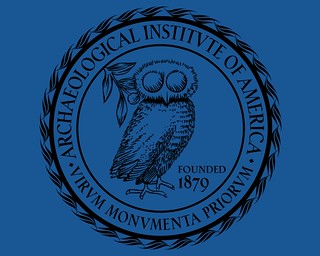 CALL FOR PAPERS: Coins as Social Artifacts
CALL FOR PAPERS: Coins as Social Artifacts
Organized by the Numismatics Interest Group of the Archaeological Institute of America
For the Annual Meeting of the Archaeological Institute of America
January 7-10, 2021
Chicago, IL
Coins are more than just indicators of a monetized society. All the activities for which people use coins are embedded in social relations and the social aspects of their use often influence the life histories of coins. From the many socially and politically influenced decisions that are involved in the making of coins (e.g., the intentionality of types for different purposes), through manipulations and alterations that suggest functions or meanings beyond their original intended purpose (e.g., piercing, graffiti, integration into other objects), to ramifications of the findspots on our interpretation of ancient societies (e.g., ritual deposition, spatial structure of coin losses), coins play an active role in social actions of many different kinds. This session welcomes papers that explore the ways in which the archaeology of coins can illuminate the meanings and roles they played in society beyond the purely economic.
Please send an abstract of no more than 500 words to Martin Beckmann (beckmam@mcmaster.ca) by February 24, 2020, in order to allow time for anonymous peer review. Please remember to make your abstract anonymous. Papers will be 15 or 20 minutes (please specify requested time) and all presenters will have to be AIA members in good standing at the time of the meeting. Please distribute this call for papers to anyone you think may be interested in submitting a proposal.
To read the complete article, see:
CALL FOR PAPERS: Coins as Social Artifacts (http://numismatics.org/nigaia/)

PERATROVICH DOLLAR RELEASE BILL GAINS GROUND
Dick Hanscom submitted this press release on behalf of the Fairbanks Coin Club. Thanks for the update! See the November 2019 article linked below for more background. -Editor
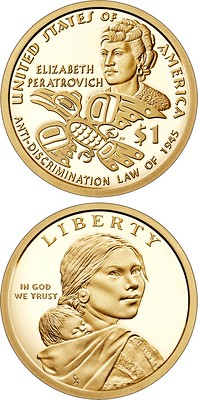 In January 2019, the Fairbanks Coin Club contacted the members of the Alaska State Legislature promoting the release of the Elizbeth Peratrovich dollar coin to circulation in Alaska. In the
spring, local 4H leaders traveled to Juneau with a group of 4h'ers as part of the 4H Youth in Government program. They lobbied all 60 legislators for a resolution calling for the release of the
Peratrovich dollar to circulation in Alaska. They also met with Paulette Mareno, Grand President of the Alaska Native Sisterhood, who has been involved with the mint since the beginning of the
planning for the Peratrovich dollar.
In January 2019, the Fairbanks Coin Club contacted the members of the Alaska State Legislature promoting the release of the Elizbeth Peratrovich dollar coin to circulation in Alaska. In the
spring, local 4H leaders traveled to Juneau with a group of 4h'ers as part of the 4H Youth in Government program. They lobbied all 60 legislators for a resolution calling for the release of the
Peratrovich dollar to circulation in Alaska. They also met with Paulette Mareno, Grand President of the Alaska Native Sisterhood, who has been involved with the mint since the beginning of the
planning for the Peratrovich dollar.
The results of the lobbying is HJR9, calling for the release of 5 million of the coins into circulation in Alaska. This was passed by the State House with one dissenting vote. Text of the
resolution can be seen here:
https://www.billtrack50.com/BillDetail/1087741
Testimony in the State House can be seen here:
https://www.ktoo.org/gavel/video/?clientID=2147483647&eventID=2019031256
Testimony on the Peratrovich Dollar begins at 23:30, and the best testimony is at 41:00
On January 22, 2020, on the second day of the 2020 session, the Senate passed HJR9 unanimously with most State Senators asking to be shown as co-sponsors. A brief article from the Juneau Daily
Empire can be seen here:
https://www.juneauempire.com/news/capitol-live-senate-meets-following-contentious-first-day/
All that remains is for it to be transmitted to the Governor, and then to officials in Washington.
To read the earlier E-Sylum article, see:
PERATROVICH DOLLAR RELEASE LOBBIED IN ALASKA (https://www.coinbooks.org/v22/esylum_v22n46a09.html)
See also:
1 dollar - Elizabeth Peratrovich and Alaska’s Anti-Discrimination
Law (https://www.coin-database.com/coins/1-dollar-coin-elizabeth-peratrovich-and-alaska-s-anti-discrimination-law-usa-2020.html)
NUMISMATISTS OF WISCONSIN 60TH ANNIVERSARY
Jeff Reichenberger of the Numismatists of Wisconsin submitted this information on the group's 60th Anniversary. -Editor
N.O.W. was established in 1960 by a small group of Wisconsin collectors including facilitator Chet Krause. Their objective was simple; to encourage and promote interest in numismatics, to cultivate friendly relations between Wisconsin collectors and local coin clubs, and to educate and assist new hobbyists.
It was decided to formally organize N.O.W. that summer at an open house in Iola at the offices of Krause Publications. On July 8th, 1960 a large crowd attended, nominations of officers were set forth and elections were made. By day’s end, N.O.W. had been formally established and the membership roll had reached nearly 100. As Chet put it, "From that day on, collectors of the state had one more element of common ground to talk about, for the idea of a state organization had come to reality."
N.O.W. has continued it's mission through the years and has maintained a solid membership base concurrent with the strength of the numismatic hobby. Our 2-day statewide conventions of the past have given way to one day yearly coin shows at various cities across the state, hosted by a local club. Our 60th Anniversary show is scheduled in Oshkosh on February 16th. All are welcome!
For more information, see the club's web site:
http://numismatistsofwisconsin.com/
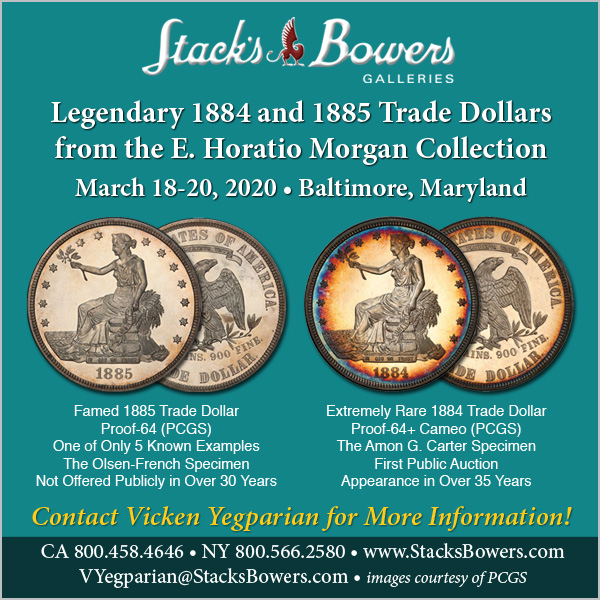
STRIKE GOLD AT 2020 ATLANTA NATIONAL MONEY SHOW
Dennis Tucker of Whitman Publishing submitted this invitation for E-Sylum readers to visit Atlanta for the ANA National Money Show. Thanks! -Editor
Strike Gold in Atlanta: Y’All Are Invited! The great state of Georgia is no stranger to organized numismatics. You might remember a few years ago when the Whitman Coin and Collectibles Expo—usually hosted in Baltimore three times a year—was held in Atlanta. The American Numismatic Association, too, has held shows in The Big Peach in recent years. And local and state groups like the Metropolitan Coin Club of Atlanta, the Rockdale Coin Club, and the Georgia Numismatic Association sponsor regular meetings, shows, and events.
Now we have another chance to enjoy some Southern charm, and (for the Yankees) a break from the cold winter, when the ANA brings its National Money Show® to Atlanta, February 27–29, 2020.
I think back to 2007 when a unique gold coin—valued then at $2.5 million—was exhibited at the Whitman Expo in Atlanta. It was an 1854 Kellogg & Co. $20 gold piece once personally owned by Augustus Humbert, United States Assayer of Gold. Also on display were the "Top Ten" pieces of paper money (as ranked in 100 Greatest American Currency Notes, by Q. David Bowers and David Sundman). That remarkable exhibit included the world’s first million-dollar-valued note, the famous Grand Watermelon. Four new Whitman books debuted at the 2007 show: the third edition of Dave Bowers’s Guide Book of Morgan Silver Dollars (today available in its sixth edition and counting!); the second edition of Dr. Cornelius Vermeule’s classic Numismatic Art in America; the wonderful 100 Greatest American Medals and Tokens, by Bowers and Katherine Jaeger (who signed copies and gave a presentation at the show); and George Tremmel’s Guide Book of Counterfeit Confederate Currency, an engaging history of the events and people involved in the production and passing of counterfeit notes during the Civil War—and the dramatic countermeasures the Confederate Treasury Department took to protect its paper money. Tremmel also gave a program, "How Much Do You Know About Counterfeit CSA Paper Money?"
Will the upcoming February 2020 ANA National Money Show bring the same level of hobby fun?
Yes indeed. Everyone is looking forward to first-class numismatic auctions, displays of ultra-rarities and famous coins, and educational programs to attract collectors from around the country.
The Appeal of Atlanta
Atlanta, Georgia, is the ninth-largest metropolitan area in the nation, with a population of six million people, and a rich numismatic history. There are tokens, medals, obsolete paper money, and scrip that hail from the "Big Peach." An hour north of Atlanta, the Dahlonega region saw the first major gold rush in the United States (in the 1820s and 1830s, years before California); it was a hotbed of private gold coinage, and later the site of a U.S. branch mint.
More recently, the Greater Atlanta metro region has been home to numismatic luminaries like die-variety expert Bill Fivaz, professional coin dealers Bob Harwell (well known for dealing in Dahlonega gold coins) and John Hamrick (who founded World-Wide Coin Investments), Southern gold specialist Al Adams, ICTA chief operating officer David Crenshaw, and "Coin Dealers Helping Coin Dealers" creator Rob Oberth. ANA governor Dr. Radford Stearns, an expert on Georgia colonial money, lived in nearby Lilburn. For more than 15 years Atlanta was the national headquarters city of Whitman Publishing, and much of the company’s publishing staff is still located there.
Atlanta is a gracious hostess. Hobbyists from the Southeast drive in comfortably from major cities including Birmingham, Nashville, Charlotte, Jacksonville, Lexington/Fayette, Greensboro, Louisville, Memphis, Orlando, Tallahassee, Columbia, and Raleigh/Durham. With the nation’s largest airport and a convenient public-transit system, it’s easy to get into and around town. The National Money Show venue, the Cobb Galleria Centre, has free parking and admission, comfortable meeting rooms, and good food.
Outside of the hobby, Atlanta is well known for its diverse restaurants, arts and culture, sports, high-end and eclectic shopping, great hotels, and of course that famous Southern hospitality. The show’s hotel, the Renaissance Atlanta Waverly, is right next to the convention center, and the Cumberland Mall is across the street, accessible by a pedestrian sky-bridge. Cumberland offers popular restaurants including Maggiano’s Little Italy, P.F. Chang’s China Bistro, Cheesecake Factory, Stoney River Legendary Steaks, Ted’s Montana Grill, Buffalo Wild Wings, Jason’s Deli, Bezoria, and more. The Cobb Energy Performing Arts Center is nearby.
Head a few miles south and you have Centennial Olympic Park, CNN Center, the World of Coca-Cola, the Children’s Museum of Atlanta, the new National Center for Civil and Human Rights, the Georgia Aquarium, Zoo Atlanta, Piedmont Park, the Atlanta Botanical Garden, the Martin Luther King, Jr., National Historic Site, and other world-class historical and educational sites and recreational venues.
Whitman Programs and Presentations at the ANA National Money Show
Whitman Publishing numismatic books, folders, albums, display cases, holders, and other hobby products will be for sale at the ANA show. Stanton Books and Stone Mountain Supply will be set up next to the ANA Museum Showcase.
Bill Bierly, author of the recently released In God We Trust: The American Civil War, Money, Banking, and Religion, will be on hand to autograph books and talk about his research. Other Whitman authors including Jeff Garrett, Bill Fivaz, and Dennis Tucker will sign books and talk with collectors.
Thursday morning, February 27, Bill Fivaz and Dennis Tucker will give presentations on cherrypicking rare die varieties and collecting modern U.S. Mint silver and gold medals. These programs are part of the ANA’s suite of one-hour "Money Talks," free and open to the public, giving people a chance to learn from their fellow numismatists, collectors, and ANA staff and members.
Thursday afternoon at 4:00 the ANA will host its Philanthropy Award Presentation and Reception (social and networking at 4:00, presentation at 5:00), celebrating Charles and Joel Anderson of Anderson Companies, owner of Whitman Publishing.
Immediately following, at 6:00, Bill Fivaz will be interviewed for the ANA Legacy Series, an ongoing program that "acquaints collectors with legends, heroes, and icons of numismatics, celebrating their lives and contributions to the hobby."
See You in Atlanta!
Come for the coins and paper money, enjoy the nice weather and everything Atlanta has to offer, pick up some exciting new Whitman books, learn from the exhibits and presentations, hunt down additions for your collection, and meet some of your favorite numismatic authors in person. It’s all at the 2020 ANA National Money Show in Atlanta. See you there!
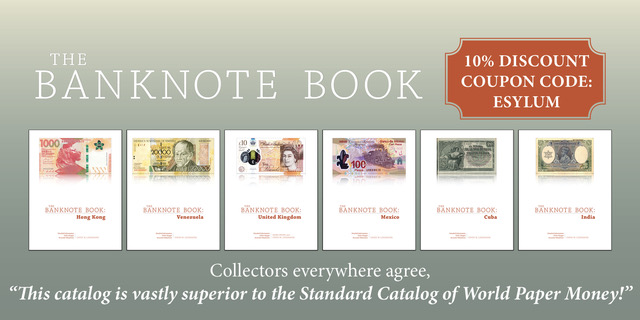
SELECTIONS FROM HOLABIRD FEBRUARY 2020 SALES
Here are some numismatic items that caught my eye in the upcoming Holabird sale. -Editor
Lot 3001: Encased Half Dollars
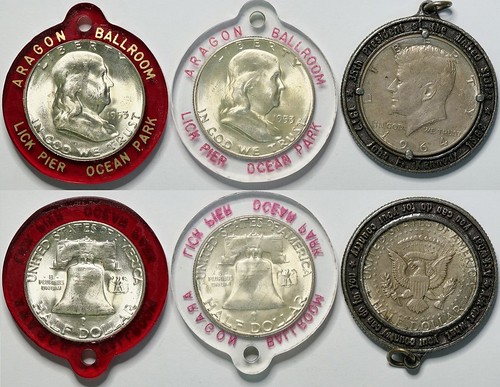
Three encased 50 cent pieces.
The first two are Franklin half dollars, dated 1953, enclosed in hard plastic enclosures. Both are silver dollars. Cases read, "Aragon Ballroom, Lick Pier, Ocean Park". The Aragon Ballroom on Lick Pier in the Ocean Park district of Santa Monica, California, was a social-dance venue opened under the Aragon name in March 1942 by Swing Shift dance promoter Harry Schooler. The ballroom and the pier, named Lick's Pier, was erected in 1922. Lick's Pier was located at the foot of Navy Street adjoining the south side of the Pickering Pier. Lick's Pier was, in 1922, almost entirely in Venice.
The third coin commemorates John F. Kennedy, 35th President of the United States. Kennedy's birth year, 1917 and year of his death, 1963, are on each side of Kennedy's name. The coin encased is a Kennedy 1964 half dollar.
Provenance: John Reynolds Collection
Nice souvenir group. -Editor
To read the complete lot description, see:
Three Encased 50 Cent Pieces, Two From Lick
Pier, Ocean Park, One Commemerates J.F.K. (111536)
(https://holabirdamericana.liveauctiongroup.com/Three-Encased-50-Cent-Pieces-Two-From-Lick-Pier-Ocean-Park-One-Commemerates-J-F-K-111536_i35646970)
Lot 3050: Masonic Pennies
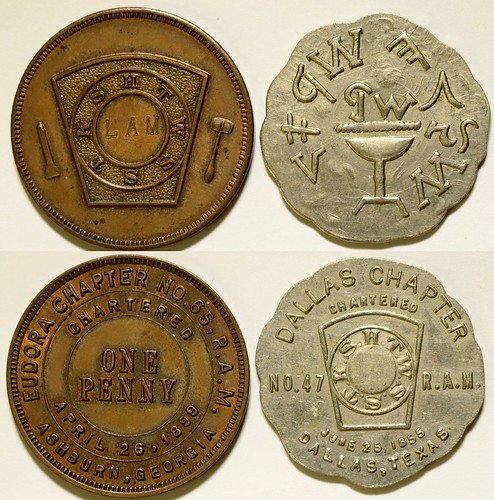
Lot of two: 1) Dallas Chapter, Dallas, TX; 2) Eudora Chapter, Ashburn, Georgia.
Provenance: John Reynolds Collection
To read the complete lot description, see:
Two Masonic Pennies (112391)
(https://holabirdamericana.liveauctiongroup.com/Two-Masonic-Pennies-112391_i35647019)
Lot 3097: California State Agricultural Association Medal
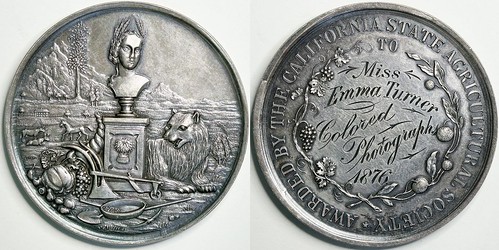
California State Agricultural Association large size silver award medal. Complex obverse design composed of images relating to California commerce, agriculture, and mining with a bust of Ceres on the central pedestal with the California bear at its base. Reverse engraved to San Francisco artist Emma Turner for Color Photography 1876. 44.6mm. Silver. Toned Unc
Provenance: John Reynolds Collection
Nice medal. Actually, it says "Colored photography". If I understand the history correctly, in 1876 color photography was still experimental. But artists and technicians would colorize black-and-white photos, typically portraits paid for by families. -Editor
For more from Wikipedia, see:
Hand-colouring of photographs (https://en.wikipedia.org/wiki/Hand-colouring_of_photographs)
To read the complete lot description, see:
California State Agricultural Association Silver Award Medal
(114073) (https://holabirdamericana.liveauctiongroup.com/California-State-Agricultural-Association-Silver-Award-Medal-114073_i35647066)
Lot 3109: French Ransom Fund Medal
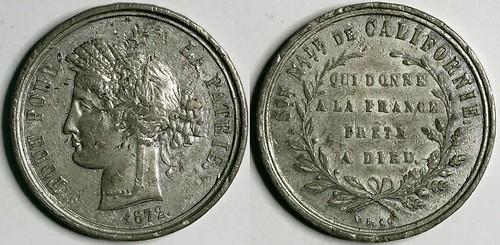
Medal struck as a thank you for donations to the French Ransom Fund (Franco-Prussian War fund). The obverse of the medal features the head of Ceres, the symbol of liberty in the Third French Republic. "CONCO" on her head band stands for Concordia symbolizing harmony among the people, nourished by peace. The reverse wreath of laurel and oak encloses the text, "QUI DONNE / A LA FRANCE / PRETE / A DIEU.," or "Who gives to France, will be repaid by God." The legend above, "SON NALE DE CALIFORNIA," translates as the "National Subscription of California." It is signed V. & CO, the hallmark of the W. K. Vanderslice & Co., a silver manufacturing firm in San Francisco later acquired by Shreve. Rare 30.1mm. WM. VF/EF
Provenance: John Reynolds Collection
Interesting piece of history. I wasn't familiar with the French Ransom Fund. -Editor
To read the complete lot description, see:
French Ransom Fund Thank You Medal (114097)
(https://holabirdamericana.liveauctiongroup.com/French-Ransom-Fund-Thank-You-Medal-114097_i35647078)
Lot 3128: Ostrich Farm Medal
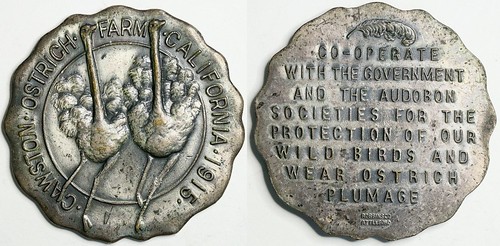
The popular ostrich farm was a weekend destination for families in the early 1900s. The 1915 date and the reverse inscription touting work with the government and Audubon societies make it possible this medal was issued for their exhibit at the 1915 Panama-California Exposition. Struck by Robbins Co. 37.16mm. Silver. Unc
Provenance: John Reynolds Collection
I can't say I've ever seen an ostrich farm medal before - or any numismatic item picturing an ostrich. Are there others? Don't judge me for wearing ostrich plumage. -Editor
To read the complete lot description, see:
Ostrich Farm Medal, Pan-Cal Exp? (114115)
(https://holabirdamericana.liveauctiongroup.com/Ostrich-Farm-Medal-Pan-Cal-Exp-114115_i35647097)
Lot 3189: Oregon-Washington Depression Scrip
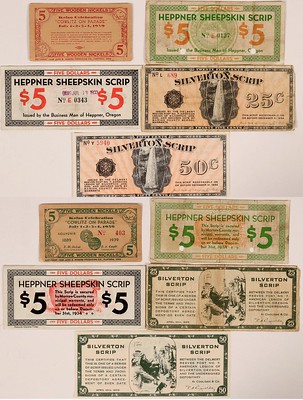 5 Pieces. Depression scrip was used during the depression era of the 1930's as a substitute for government issued currency. Because of the banks closing temporarily and the lack of
physical currency, someone had to come up with another form of currency to keep the economy going and a way for trade to continue.
5 Pieces. Depression scrip was used during the depression era of the 1930's as a substitute for government issued currency. Because of the banks closing temporarily and the lack of
physical currency, someone had to come up with another form of currency to keep the economy going and a way for trade to continue.
1. Two Silverton Scrip of Oregon. Both black border, orange underprint, vignette of waterfall, American Legion logo, dated April 1933. #689, 25c, F-VF cond. 50c, dateline April 1933, EF cond.
2. Two Heppner Sheepskin Scrip, $5, #E0343 (VF) and E0137(F), Issued Heppner, Ore. 1933, backed by Morrow County Municipal warrants.
3. Kelso Washington State Golden Jubilee 1959. Five wooden Nickels Face green border, vignette Buffalo and Indian in corners, reverse in red same vignettes. Very good condition.
Provenance: John Reynolds Collection
The Sheepskin Scrip is well known - I wasn't familiar with the Silverton Scrip notes. Nice group. -Editor
To read the complete lot description, see:
Oregon/Washington Scrip (currency) (112455)
(https://holabirdamericana.liveauctiongroup.com/Oregon-Washington-Scrip-currency-112455_i35647158)
Lot 3194: The Numismatist
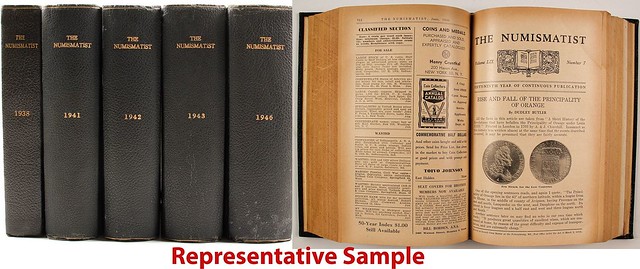
This exceptional Numismatist Library is x-Bob Johnson Collection, long time San Francisco dealer. Subtitled "An Illustrated Monthly Devoted to the Science of Numismatics," it contains 54 volumes, 1888-1953 Index, then 1894-1953, missing only the 1888-1893, 1907. All are hard bound by year in black bindings with gilt edge/binding lettering. This is one of the most important research series for any advanced numismatist. All in excellent condition.
Still essential for numismatic bibliophiles and researchers. Web sites make it easy to search for and find information, but reading is easy and pleasant when you can just pull the volume off your shelf and sit back. -Editor
To read the complete lot description, see:
Numismatist- Nearly Complete Run (75562)
(https://holabirdamericana.liveauctiongroup.com/Numismatist-Nearly-Complete-Run-75562_i35647163)
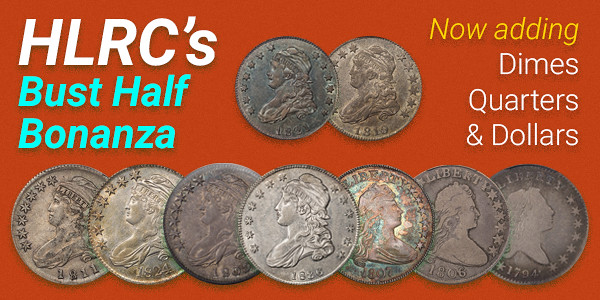
NUMISMATIC NUGGETS: FEBRUARY 2, 2020
Here's a selection of interesting or unusual items I came across in the marketplace this week. Tell us what you think of some of these. -Editor
L. Plautius Plancus Denarius
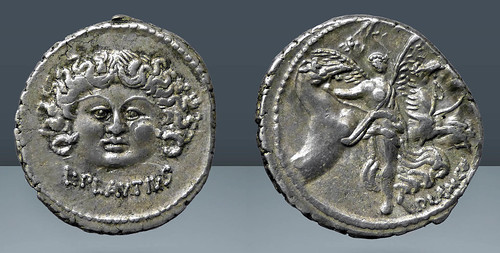
L. Plautius Plancus, Rome, 47 BC
AR Denarius, 3.61g (16mm, 7mm). Facing mask of Medusa with disheveled hair; coiled serpents flanking / Victory (or winged Aurora) flying right, head slightly left, holding reins and conducting four rearing horses of the sun.
References: Crawford 453/1a-b CRI 29; Sydenham 959-959a; Plautia 15-15a; RBW 1583-4
Grade: Small indentation on cheek but otherwise well-centered and good strike. EF/aEF (rr1076)
From Shanna Schmidt - Coin of the Week. -Editor
To read the complete lot description, see:
L. Plautius Plancus, Rome, 47 BC
(https://www.shannaschmidt.com/roman-repuclic/l-plautius-plancus-rome-47-bc?rq=rr1076)
AW counterstamp on Connecticut Cent
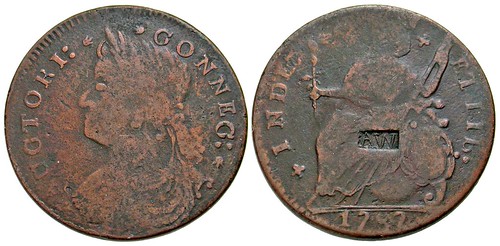
Lot 353. Colonial America. Connecticut. 1787. Copper. Rare, AW counterstamp. Ex New England Rare Coin Auctions 1976, lot 135. Colonial America. Connecticut. 1787. Copper. Miller 37.9-e. VERY GOOD-10. Rare, AW counterstamp.
Ex New England Rare Coin Auctions 1976, lot 135.
The Wyler book of Old Silver has a silversmith's mark, a small rectangle with AW for Antipas Woodward, Middletown, Conn., from about 1791. That is probably his mark. Of special interest is that Antipas Woodward was "Sealer of Weights and Measures" for the town of Plymouth Connecticut in the 1790's, which may be tied to this counterstamp.
From the upcoming Agora Auctions sale. -Editor
To read the complete lot description, see:
Lot 353. Colonial America. Connecticut. 1787. Copper. Rare, AW counterstamp. Ex New England Rare Coin Auctions 1976, lot 135.
(https://agoraauctions.com/listing/viewdetail/47736)
1903 Lloyd McKim Garrison Medal
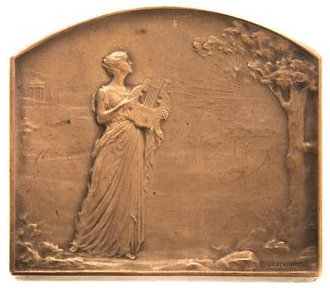
1.) Franklin Birthday Dinner/ Typothetae of the City medal, January 17 1902 64.2mm x 57mm 92.8 grams 2.) 1899 Delacour (clovis) galvano plaque mounted on stained oak frame (209.8mm x 195.6 mm)n, Medal 162.8 mm x 144 mm. Stain on center of medal plaque 3.) 1904 University of Wisconsin 50th Anniversary plaque on wood frame. Medal 54.8 g, 62.5mm x 47.3 mm 4.) 1903 Lloyd McKim Garrison Medal (Harvard) blank name, 81.7 g, 60.77mm x 52.2 mm cast by Henry Bonnard Bronze Company 5.) 1907 Engineering Societies Building Donated by Andrew Carnegie medal, 101.8g, 74.2 x 53.9, reverse has lighting from the clouds re Ben Franklin and several spots of tape residue 6.) 1900 Saltus (J.Sanford) galvano plaque (63.7mm x 54.5mm) on mahogony frame (121.6mm x 90.6 mm)
Provenance
#1-5: The Lucas family Collections, Baltimore, Thence by descent to Bertha Lucas (died 1943) Bequeathed by Bertha Lucas to the manager of Lucas Brothers, Jesse G. Kaufman, 1943 Thence by descent to
the present owner. #6 - William F. Lucas Jr, Baltimore (died 1928) Thence by descent to Bertha Lucas (died 1943) Bequeathed to manager of Lucas Brothers, Jesse G. Kaufman., 1943 Thence by descent to
present owner.
From the February 6, 2020 Alex Cooper sale. Part of a lot of six medals. -Editor
To read the complete lot description, see:
SIX WORKS BY VICTOR DAVID BRENNER
(https://bid.alexcooper.com/lots/view/1-2MGPB0/six-works-by-victor-david-brenner)
1910 William H Welch Medal
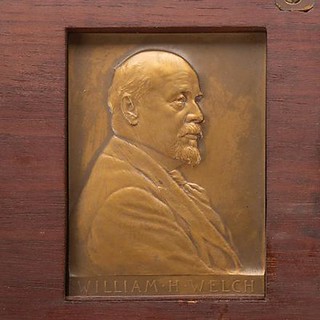
Description
1.) 1825-1925 100th Anniversary of Maryland Institute College of Art (silver- 50.87 mm and 57.5g) In original case 2.) James Cardinal Gibbons Jubilee Medal, 1911 by Michael Jenkins and Joseph Miller.
President Taft honored him in 1911, the 50th Anniversary of his priesthood and the 2nd American to make cardinal, Baltimore Basilica on Reverse 3.) By Victor D. Brenner- (1910) William H Welch
"from his friends" Welch was first full-time faculty member at Johns Hopkins and first Dean of the Medical School - 2 part plaque in wooden frame 4.) Official's medal from 1922
Institutional championship for Baltimore Public Athletic League with original ribbon in good condition Condition
1.) 50.87 mm, 57.5 g silver 2.) 70mm 118.3 grams bronze Provenance
#1) William F. Lucas Jr, Baltimore (died 1928) Thence by descent to Bertha Lucas (died 1943) Bequeathed to manager of Lucas Brothers, Jesse G. Kaufman., 1943 Thence by descent to present owner. #2-4)
The Lucas family Collections, Baltimore, Thence by descent to Bertha Lucas (died 1943) Bequeathed by Bertha Lucas to the manager of Lucas Brothers, Jesse G. Kaufman, 1943 Thence by descent to the
present owner.
From the February 6, 2020 Alex Cooper sale. Part of a lot of four Baltimore-related medals and plaques. -Editor
To read the complete lot description, see:
FOUR BALTIMORE RELATED MEDAL/PLAQUES
(https://bid.alexcooper.com/lots/view/1-2MGPAW/four-baltimore-related-medalplaques)
1917 Anti-Protestant Propaganda Medal
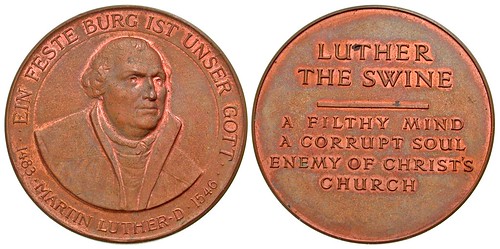
Lot 360. U.S.A.. Anti-Protestant Propaganda. 1917. Copper color medal. Medallion Commemorating the 500th Anniversary of the Reformation. EIN FESTE BURG IST UNSER GOTT ··1483 MARTIN LUTHER-D ·1546··. Rare.
U.S.A.. Anti-Protestant Propaganda. 1917. Copper color medal (38.2 mm). Medallion Commemorating the 500th Anniversary of the Reformation. EIN FESTE BURG IST UNSER GOTT ··1483 MARTIN LUTHER-D ·1546··. LUTHER THE SWINE ? A Filthy Mind, A Corrupt Soul, Enemy Of Christ?s Church. Mint State. Rare
From the upcoming Agora Auctions sale. -Editor
To read the complete lot description, see:
Lot 360. U.S.A.. Anti-Protestant Propaganda. 1917. Copper color medal. Medallion Commemorating the 500th Anniversary of the Reformation.
EIN FESTE BURG IST UNSER GOTT ··1483 MARTIN LUTHER-D (https://agoraauctions.com/listing/viewdetail/47743)

LUDICA OF MERCIA COIN CONFOUNDS EXPERTS
David Sundman passed along this Sunday Times article about a medieval coin prompting experts to rewrite the history of its era. Thanks! -Editor
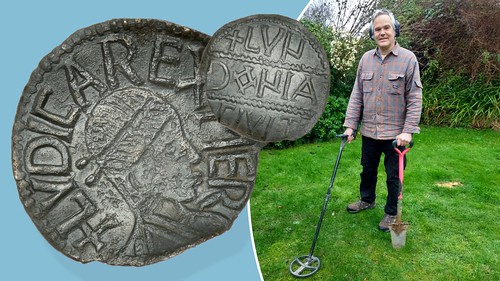
The febrile history of England in the 9th century is being rewritten after the discovery of a coin struck on the orders of an obscure Anglo-Saxon king.
The silver coin, bearing the image of Ludica of Mercia, was considered so controversial that experts dismissed it as a fake until metallurgical analysis supported its authenticity.
The coin confounded expectations because the kingdom of Mercia was thought to have lost control of Lundenwic, where the West End of London is now, after it lost a battle against the rival kingdom of Wessex in September of AD825.
The Battle of Ellendun, near where Swindon now stands in Wiltshire, was thought to have been a decisive victory for Wessex, about 50 years before it was taken over by Alfred...
To read the complete article, see:
Detectorist rewrites history with 1,200-year-old coin
(https://www.thetimes.co.uk/article/detectorist-rewrites-history-with-1-200-year-old-coin-crphbwxgt)

LATVIA HONEY COIN NAMED COIN OF THE YEAR WINNER
Numismatics Editor Maggie Judkins of Active Interest Media passed along this press release about this year's Coin of the Year winners. Thanks. -Editor
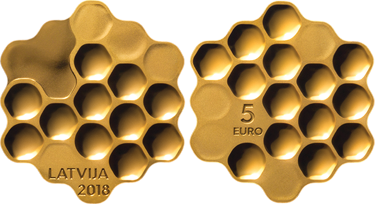
The day was sweet as honey for the Bank of Latvia when its 5-euro Honey Coin was given top honors as 2020 Coin of the Year during an awards ceremony held Feb. 1 in conjunction with the World Money Fair in Berlin, Germany.
The Coin of the Year awards program, now in its 37th year, is an internationally conducted competition presented by World Coin News to recognize outstanding coin design and innovation worldwide. The 2020 program, sponsored by The Journal of East Asian Numismatics and the World Money Fair, honored coins dated 2018 in 10 categories of competition as decided by an international panel of judges.
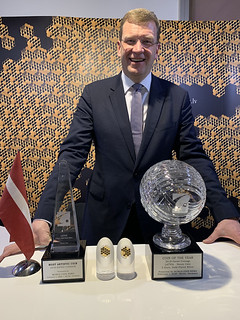 The Honey Coin is styled as a honeycomb in gold-plated silver by artist Arturs Analts. The Bank of Latvia calls it "a symbol of diligence and sweetness of work." It was voted
number-one from a pool of 10 category-winning coins, where it had come out on top in the Most Artistic Coin category.
The Honey Coin is styled as a honeycomb in gold-plated silver by artist Arturs Analts. The Bank of Latvia calls it "a symbol of diligence and sweetness of work." It was voted
number-one from a pool of 10 category-winning coins, where it had come out on top in the Most Artistic Coin category.
"The impact of bees on both our ecologies and economies is fast being recognized as mammoth, so this simple and elegant design presents a lovely counterpoint to focus human response," said Tom Michael, Coin of the Year coordinator and awards ceremony presenter.
Michael also coordinates the COTY nominating committee, whose job is to select 100 nominees from the more than 1,000 coins submitted for consideration by mints across the globe. He recalls the Latvian coin holding its own during the process.
"Of the many honey-themed coins we considered for nomination, this one really stood out," he said. "Nominated by both the issuer and committee member Donald Scarinci, the Bank of Latvia Honey Coin garnered strong support from the judges and won by a very wide margin."
Janis Blums, head of cash department and board member for the Central Bank of Latvia, was in attendance to accept the award.
Following is the list of 2020 category winners.
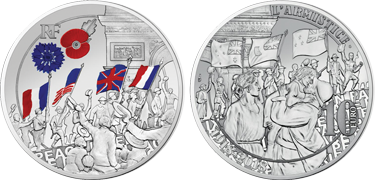
Most Historically Significant Coin
Monnaie de Paris
10 Euro, Silver with Color
Great War: People's Jubilation
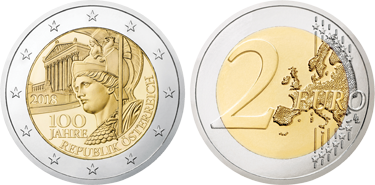
Best Circulating Coin
Austrian Mint
2 Euro, Bi-metallic
100th Anniversary of the Founding of the Austrian Republic
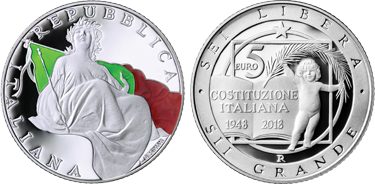
Best Contemporary Event Coin
Italian Mint
5 Euro, Silver with Color
70th Anniversary of the Italian Constitution
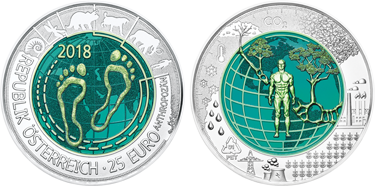
Best Bi-Metallic Coin
Austrian Mint
25 Euro, Bi-metallic
Anthropocene
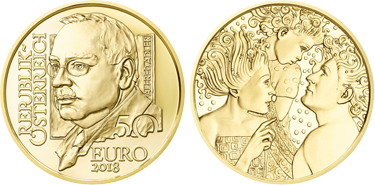
Best Gold Coin
Austrian Mint
50 Euro, Gold
Vienna Schools of Psychotherapy: Alfred Adler

Most Artistic Coin
Bank of Latvia
5 Euro, Gold-Plated Silver
Honey Coin
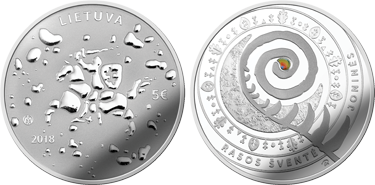
Best Silver Coin
Lithuania Mint
5 Euro, Silver with Color
Jonines: Rasos Švente

Most Innovative Coin
Lithuanian Mint
5, 10, 20 Euro, Silver; 50 Euro, Gold
100th Anniversary of the Restoration of Lithuania Independence
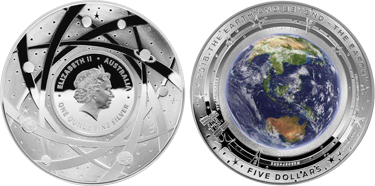
Best Crown Coin
Royal Australian Mint
5 Dollars, Silver with Color, Curved
The Earth and Beyond: Earth
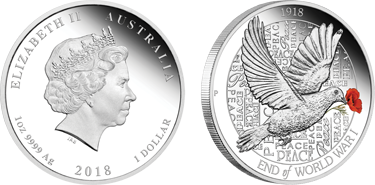
Most Inspirational Coin
Perth Mint
1 Dollar, Silver with Color
100th Anniversary of the End of World War I
To view this story online, visit https://www.numismaticnews.net/article/coin-of-the-year-goes-to-latvia .
For more details on the voting process and information for all 100 of the 2020 nominees, visit https://www.numismaticnews.net/coin-of-the-year/nominees-for-2020-coin-of-the-year-awards-determined .
About Coin of the Year
The Coin of the Year awards program is an internationally conducted competition sponsored by World Coin News, a division of Active Interest Media, to provide recognition of outstanding coin design
and marketing efforts worldwide, and to stimulate other governments to greater participation in both areas.
About World Coin News
The fascinating history and details of world coins are brought to life monthly in World Coin News, the leading authority on world coins. The magazine reports on new issues, auctions and other coin
news from around the world. Its top experts provide in-depth historical information on coins and the countries that issue them.

STRIKE YOUR OWN OWN BREXIT 50P EVENT POPULAR
The new Brexit coins were popular with visitors to the Royal Mint's headquarters in Llantrisant, Wales. Here's an excerpt from a Wales online article. -Editor
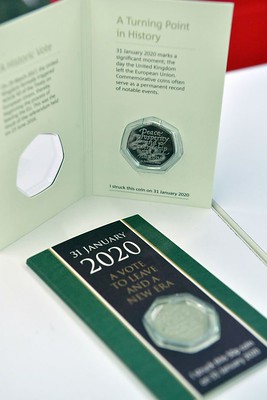 Phil and Sheila Walmsley live in Southport in Lancashire, a trip of more than five hours from Llantrisant in south Wales.
Phil and Sheila Walmsley live in Southport in Lancashire, a trip of more than five hours from Llantrisant in south Wales.
Yet the couple wanted to find a special way to celebrate leaving the European Union so made the journey to join the Royal Mint's one-off 'historic Brexit tour' at which they could strike their own Brexit 50p.
They were joined by coin collectors, one of whom had driven from Scotland for the event, and other Brexit supporters keen to be the first to get their hands on an official Brexit coin, with the message: "Peace, prosperity and friendship with all nations."
Two thousand tickets for the event sold out in less than 24 hours as people from all over the UK: remainers, Brexiteers and coin collectors alike, flocked to get their own piece of history.
They purchased one strike your own coin on the day of the tour for £10 to share between them.
The strike your own coin experience has been running since 2016, with many coin collectors from all over the UK returning to the country for each event in order to ensure their collection was complete.
This is the forth coin commemorating the UK's relationship with the EU since its membership in 1973. The first was released that year to mark the joining of the union, a further two coins were released in 1992/93 and in 1998, the second to mark John Major taking over the rotating presidency of the European Council, and the third to mark the 25th anniversary.
One coin collector drove 12 hours from Dundee in Scotland to ensure he had this forth coin to complete his collection of British coins marking the relationship with the EU.
It was the first time Paul Grey, who lives in Jersey, visited The Royal Mint.
He said it was luck of timing that he happened to be visiting family in Lydney, near Gloucestershire, when it was announced The Royal Mint were holding the special event.
To read the complete article, see:
'We drove across the UK to celebrate Brexit Day by striking our own 50p coin'
(https://www.walesonline.co.uk/news/wales-news/we-drove-across-uk-celebrate-17667440)
To read the earlier E-Sylum article, see:
BRITAIN’S NEW BREXIT 50P COIN (https://www.coinbooks.org/v23/esylum_v23n04a27.html)
BREXIT 50P BOYCOTT OVER OXFORD COMMA
Not everyone was happy about the new Brexit 50p coin. Thanks to Dick Hanscom and Dennis Tucker for forwarding this BBC News story. -Editor
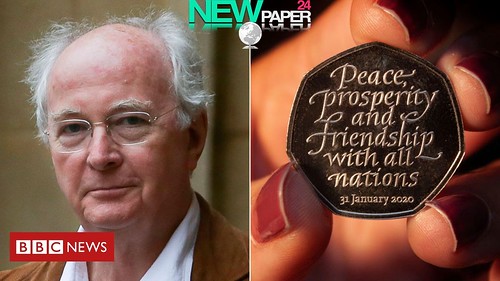
Dennis Tucker writes:
"I’m sure every reasonable E-Sylumer will agree that this is an error coin --- of the typographical variety, not of the die variety. This might inspire an interesting manuscript idea: "100 Greatest Errors on Coins."
"If anyone disagrees about the Oxford comma, take the advice of a wise old Civil War token and "shoot him on the spoot"!
Sir Philip Pullman has declared battle on the brand new Brexit 50p – nevertheless it’s nothing to do with politics.
Sir Philip has taken umbrage as a result of the Oxford comma is lacking from the coin’s wording: "Peace, prosperity and friendship with all nations."
The Oxford comma is included earlier than the ultimate "and" in lists however it isn’t used universally and is commonly a subject of debate for grammar fans.
Stig Abell, editor of the Occasions Literary Complement, agreed with Pullman, tweeting: "The lack of a comma after ‘prosperity’ is killing me."
However Susie Dent, from Countdown’s Dictionary Nook, mentioned the Oxford comma was optionally available.
"Sure it’s optionally available: it clarifies issues very often although, and I simply discover it simpler and extra constant to make use of it on a regular basis," she tweeted.
On Sunday, Tony Blair’s former spin physician Alastair Campbell said he would be asking shopkeepers for "two 20p pieces and a 10" relatively than settle for the brand new 50p coin.
Dave Bowers adds:
"The 2005 Westward Journal nickel has OCEAN IN VIEW as the direct quote from the Lewis & Clark journal, whereas it should have been OCIAN IN VIEW. At the time I contacted the Mint and was told that the inscription was indeed wrong, but to give the original would have made the public think the Mint had made a mistake!"
To read the complete article, see:
Sir Philip Pullman requires 50p boycott over Oxford comma
(https://newpaper24.com/sir-philip-pullman-calls-for-50p-boycott-over-oxford-comma-newpaper24/)
To read the earlier E-Sylum articles, see:
ON USING THE SERIAL COMMA (https://www.coinbooks.org/esylum_v16n52a09.html)
MORE ON USING THE SERIAL COMMA (https://www.coinbooks.org/esylum_v16n53a13.html)
STILL MORE ON THE SERIAL COMMA (https://www.coinbooks.org/esylum_v17n01a14.html)
ROYAL MINT ALPHABET COINS A BOON FOR VISITORS
The Royal Mint's offer to sell examples of its Alphabet coins is proving profitable to frequent visitors. -Editor
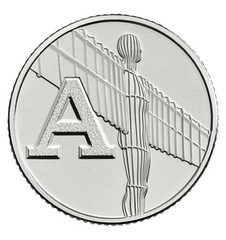 People have come up with a clever scheme for making a tidy profit from the Royal Mint Experience.
People have come up with a clever scheme for making a tidy profit from the Royal Mint Experience.
In 2018 the Royal Mint released more than two million 10p coins that had a different letters of the alphabet.
The A-Z coins had designs featuring British icons like the fry-up and the red letter box.
Though they only have a face value of 10p these coins sell for far more on websites like eBay.
Now cunning coin hunters have been taking advantage of a special offer at the visitor attraction at Pontyclun.
Every Tuesday, Friday and Sunday from 10am until 2pm, if you bring a standard 10p coin or small change they will swap it for up to 10 A-Z coins.
People then take the coins and sell them for over 100x face value online.
The most popular is the Jubilee coin which is sold for over £12.
One coin collector based in Cardiff who didn't want to be named told WalesOnline: "Loads of people are doing it. You just go down and swap three times a week and then make a profit on Ebay. Click on the sellers - they are all from Cardiff and south Wales. "
To read the complete article, see:
The ingenious way people are making free money from the Royal Mint Experience
(https://www.walesonline.co.uk/whats-on/whats-on-news/royal-mint-alphabet-10p-coin-17652715)
To read an earlier E-Sylum article, see:
THE ROYAL MINT'S NEW 10-PENCE COINS (https://www.coinbooks.org/v21/esylum_v21n09a35.html)

THE CITY OF CHARLESTON FREE BADGE
Researcher John Kraljevich posted a great article on Facebook about the City of Charleston Free Badge. With permission, we're republishing it here. -Editor
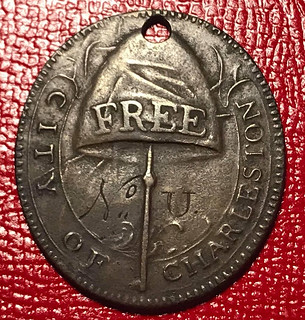 Every Black History Month, friends who know of my interest in African-American history ask questions. Some of the most common ones are:
Every Black History Month, friends who know of my interest in African-American history ask questions. Some of the most common ones are:
• Why do we have Black History Month?
• Why didn't I ever learn about any of this stuff in school, beyond Jackie Robinson and George Washington Carver and maybe Harriet Tubman?
• Is Black History Month really necessary anymore?
I think all of these questions are best answered by teaching one concept.
The past is everything that happened before this moment: good and bad, famous people and anonymous people, moments and storylines and broad themes. If it happened before right now, it's the past.
History is the story we choose to tell about the past. The history we learn in schools tends to be a story about presidents and generals and wars and endless progress. But there are lots of histories, in fact, there are infinite histories. And that means "history" isn't right or wrong, nor is it ever complete. It is always an edited, even biased, version of a narrative about the past.
In America, the dominant narrative begins in 1607 or 1620 and tends to be very white and very male. Non-coincidentally, the victors of most of the struggles and the writers of most of the history tended to be the same.
Black History Month offers an opportunity to tell a different narrative. Too often (for my taste at least), it's a narrative about the same handful of freedom fighters, a lot of very famous entertainers and athletes, and perhaps a scientist or two. But African-Americans since 1607 (or earlier, if you wish) have faced struggles no other group have faced (please, you don't want to come at me with tales of "Irish slavery," I promise you) and thus have seen successes that no other group can claim. Sure, there were a million banks, but the Douglass National Bank of Chicago -- the first black-owned national bank -- was special. Of course, there were a million historians, but W.E.B. DuBois’ entire career and perspective represented generations of hard work distilled through his pen. And certainly, there were other poetesses of the Revolutionary Era other than Phillis Wheatley, but none so captured the imagination of the era that declared All Men Are Created Equal, nor offered so much contrast, than a woman of letters who was born free in Africa, enslaved, and emancipated.
Phillis Wheatley was legendary in her day, feted by the Founders. She died in 1784, when her husband was in prison, just months after the death of her infant child. Her only remaining child, also an infant, died soon enough thereafter to be buried with her mother.
I collect a lot of things, but collecting numismatic (related to coins, medals, and paper money) items related to African-American history is my most intensely pursued specialty. This month, I'll share some items from my collection. This first piece is the object of which I'm most proud, but it also illustrates some of the points of this post.
History is the story we choose to tell about the past. And the story we tend to tell in the United States is a tale of progress moving upward and onward, endlessly better, climbing the mountain of righteousness.
The illustrated object is a badge from the City of Charleston, South Carolina, issued only between 1783 and 1789. It depicts a freeman's cap, called a pileus, on a pole, a symbol of liberty that was common during the Revolutionary War and the decades that followed.
In the ardent spirit of freedom that followed the American Revolution, emancipations -- freeing enslaved African-Americans -- reached a height not seen for several decades after. As time went on, emancipations decreased, and as the Revolutionary generation passed, race-related laws and restrictions became harsher, more numerous, and more widespread. Many Southern states made emancipations all but illegal, and when they were permitted, emancipated people were ejected from the state on pain of re-enslavement.
This badge, one of just a handful known to exist, is a relic of a brief period (just six years!) when a small number of African-Americans in Charleston could enjoy a brief flicker of relative freedom. It's a reminder that progress, especially for African-Americans, goes back and forth, one step forward and two back, and that our national ideals and the language used to describe them does not often match our national policies. This is as true in 2020 as it was in 1789.
The person who wore this on their person was free in the decade that followed the American Revolution. We will never know if they remained free, nor if their descendants did.
Though in my personal collection, this piece is on loan and will be displayed at Colonial Williamsburg through 2026.
To read the complete article, see:
https://www.facebook.com/photo.php?fbid=10222060819689347&set=a.1270265316554&type=3&theater
Thanks, John, for a great history lesson and a fantastic numismatic artifact. Saul Teichman located a super online article about these. Here's an excerpt. -Editor
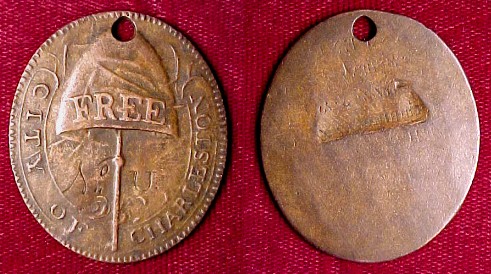
Many exonumia collectors are familiar with the Charleston Slave-For-Hire Badges. Commonly called "slave tags," they were issued annually from 1800 to 1865 by the city of Charleston in an attempt to regulate the practice of slaves being hired out by their masters. Only a knowledgeable few, however, are aware of their earlier "cousins," the City of Charleston Free Badges. This is not surprising due to the relative rarity of the latter. Surviving slave tags probably number between one and three thousand, with new ones coming out of the ground on a regular basis. But the number of known free badges can be counted on two hands and the discovery of a new specimen is a noteworthy event. The author hopes this webpage will serve as a clearinghouse of information on the little-known free badges as well as an ongoing census for the same.
The City of Charleston Free Badges, sometimes referred to as Free Black Tags or Freedmen's Badges, are thought to have been made in the last months of 1783 or early in 1784. In November of 1783, a city ordinance was passed which stated that "every free negro, mulatto, or mestizo, above the age of fifteen years, shall be obliged to obtain a badge from the Corporation of the City, for which badge every person shall pay into the City Treasury the sum of Five Shillings, and shall wear it suspended by a string or ribband, and exposed to view on his breast." The penalty for not adhering to the law was a fine of three pounds, and if not paid within 10 days the violator could be sentenced to the workhouse (jail) and hard labor for up to 30 days.
The same law which required free persons of color to obtain and wear the free badges also attempted to regulate the practice of hiring out slaves. It set up fees for "tickets or badges" for hired slaves, as well as fines for those owners hiring out unticketed slaves and those who employed them. No slave tags exist with dates earlier than 1800 and it is thought that perhaps paper tickets were used instead of the usual brass badges which were instituted later.
In 1789, the law requiring tickets for slave hiring and badges for free persons of color was abolished, and was not to be replaced until 11 years later (in 1800) with a new law governing only slave hiring practices. There was no mention of badges for free blacks in the 1800 ordinance, nor was there in any subsequent ordinances or regulations. Therefore, the time period in which free persons of color were required to wear badges lasted only six years, from November of 1783 until 1789. All existing free badges are undated and there was no wording in the 1783 ordinance calling for annual renewal, so apparently once the badges were issued, they were good "in perpetuity." These two facts - the short-lived nature of the ordinance calling for the badges themselves and the fact that they did not need to be renewed annually - may account for the relative rarity of the free badges. Additionally, there were less than 600 free blacks living in Charleston in 1790 (U.S. Census figures) and many of that number were undoubtedly children younger than 15 years of age.
There is no mention in the 1783 ordinance as to what entity was to manufacture the free badges and no evidence has turned up in any official source as to the identity of the manufacturer. It is possible that they were made by a local silversmith or goldsmith, as the later slave tags were. (Slave tags from the early 1800s often had the manufacturer's name on them.) However, the style of the free badges differs significantly from the later slave tags.
All known genuine free badges were die struck in relief on oval copper planchets (or in one case silver) by use of a single obverse die. A Phrygian cap (liberty cap) on a pole is the central device of the obverse, with the word "FREE" appearing on the lower edge of the cap.
To read the complete article, see:
Item of the Month #26 - The City of Charleston Free Badge (http://www.angelfire.com/sc2/tokenofthemonth/token026/)
1899 EXPOSITION PROVINCIALE AWARD MEDALS
Gary Greenbaum writes:"With the comments on award medals, I’d like to show everyone this, that I bought last fall in Corfu in Greece. I’m not sure what product won the medals and it seems to be missing at least one, but at eight euros, the price was right."
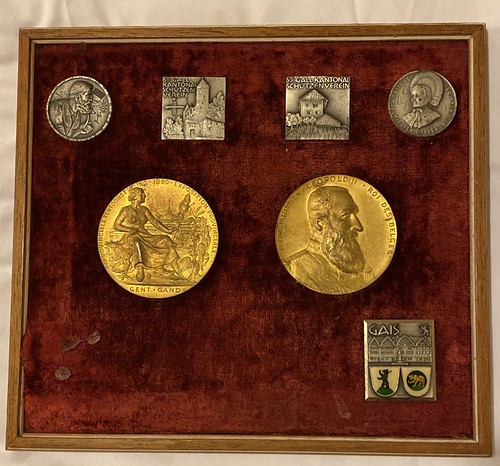
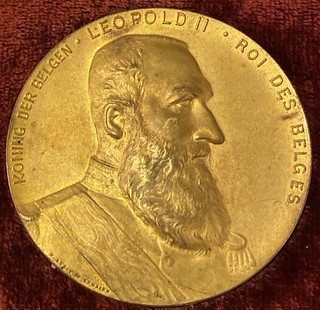
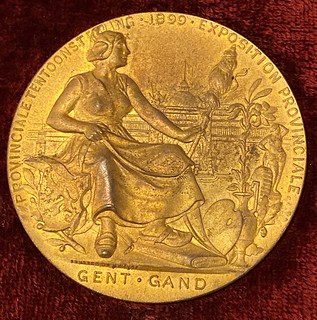
Nice. Thanks! Great find. -Editor
To read the earlier E-Sylum article, see:
BORDEAUX EXPOSITION MEDAL EPHEMERA (https://www.coinbooks.org/v23/esylum_v23n04a13.html)
ECKERT'S ENIAC COMPUTER JOHN SCOTT MEDAL
Heritage Auctions is offering an important medal in the history of science and technology - John Presper Eckert Jr.'s John Scott Medal for the invention of the first large-scale electronic computer, the ENIAC. Here's the press release. -Editor
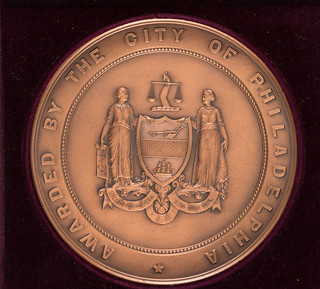
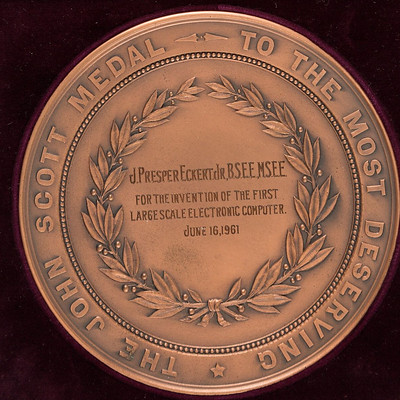
A medal awarded for one of the most significant technological advancements in the last century is among the most intriguing lots offered in Heritage Auctions’ Americana & Political Auction Feb. 22-23 in Dallas, Texas.
The John Scott Medal Awarded to John Presper Eckert Jr. in 1961 "For The Invention Of The First Large Scale Electronic Computer" Known as the ENIAC carries a pre-auction estimate: $10,000+, but there is a very real chance the return at auction could far exceed that total.
The copper medal, with a 102-mm diameter and bearing the seal of the city of Philadelphia, is given by the city to "the most deserving" men and women whose inventions have contributed in some outstanding way "to the comfort, welfare and happiness" of mankind. The first medal was issued in 1822.
"Computers are such an integral part of our everyday lives, at home, at work, in our cars … everywhere," Heritage Auctions Americana Director Tom Slater said. "The importance and value of computers that evolved from Eckert’s invention can not be overstated."
The ENIAC not only was the first large-scale computer, but also the first reprogrammable general-use computer.
The reverse of the medal, which was shared by Eckert and John Mauchley, his partner in the development of the computer, reads: "The John Scott Medal – To The Most Deserving" with engraved text at center surrounded by laurel branches: "J. Presper Eckert Jr, BSEE, MSEE/ For The Invention Of The First/ Large Scale Electronic Computer./ June 16, 1961." It is enclosed in a custom leather case that measures 5 by 5-1/2 by 1 inch, with "John Scott Medal/ J. Presper Eckert, Jr." embossed in gold on the top. This medal comes from the collection of Eric C. Caren, whose collecting interests ranged from newspapers to posters to broadsides to manuscripts and eyewitness letters.
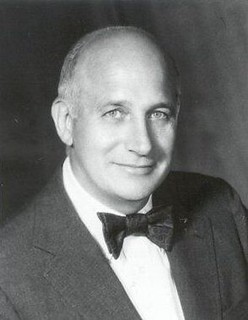 J. Presper "Pres" Eckert was born in 1915 in Philadelphia. His high school interest in engineering earned him invitations into the laboratory of television inventor Philo Farnsworth, and
eventually convinced him to switch his major at the University of Pennsylvania from business to engineering. He earned his first patent at 21, and three years later was awarded a contract to develop
a computing machine using (then)-fast vacuum tubes. The ENIAC was completed two years later, in 1945, and unveiled for the public the following year.
J. Presper "Pres" Eckert was born in 1915 in Philadelphia. His high school interest in engineering earned him invitations into the laboratory of television inventor Philo Farnsworth, and
eventually convinced him to switch his major at the University of Pennsylvania from business to engineering. He earned his first patent at 21, and three years later was awarded a contract to develop
a computing machine using (then)-fast vacuum tubes. The ENIAC was completed two years later, in 1945, and unveiled for the public the following year.
Eckert and Mauchley started their own company, the Electronic Control Company, in 1946, and three years later built the Binary Automatic Computer (BINAC), which featured the first stored-program (magnetic tape) in the United States. They received an order from the National Bureau of Standards to build the UNIVAC, the first of which was bought and dedicated March 31, 1951, by the United States Census Bureau. The UNIVAC was the first American computer designed for business and administrative use.
The notoriety of the machine and the potential of computer technology got a considerable boost when Eckert’s company teamed up with CBS News to predict the outcome of the 1952 Presidential election. Despite polls showing Adlai Stevenson as the race’s leader, the UNIVAC predicted Dwight Eisenhower would win a lopsided victory. The projection was dismissed by skeptics, but ultimately proved to be accurate.
Other winners of the John Scott Medal include such scientific luminaries as Thomas Edison, Marie Curie, the Wright Brothers and Jonas Salk.
For images and information about this and the rest of the 966 lots in the auction, visit HA.com/6215 .
Here's an excerpt from the lot description. -Editor
In the eminent company of Thomas Edison, Nikola Tesla, Marie Curie, the Wright Brothers, Guglielmo Marconi, Alexander Fleming, and Jonas Salk.
The John Scott Medal Awarded to John Presper Eckert Jr. in 1961 "For The Invention Of The First Large Scale Electronic Computer" Known as the ENIAC. A beautiful and impressive copper medal of 102mm diameter and 496 grams bearing the seal of the city of Philadelphia ("Philadelphia Maneto" or "Let Brotherly Love Endure") on the obverse with the text around: "Awarded By The City Of Philadelphia". The reverse bears the text around: "The John Scott Medal - To The Most Deserving" with engraved text at center surrounded by laurel branches: "J. Presper Eckert Jr, BSEE, MSEE/ For The Invention Of The First/ Large Scale Electronic Computer./ June 16, 1961". It is enclosed in a custom 5" x 5.5" x 1" leather case with "John Scott Medal/ J. Presper Eckert, Jr." embossed in gold on the top. The award that year was shared by Eckert and John Mauchley, his partner in the development of the computer.
The John Scott Award is given by the city of Philadelphia to "the most deserving" men and women whose inventions have contributed in some outstanding way to the "comfort, welfare, and happiness" of mankind. In this particular case, one would be hard-pressed to think of an invention that has affected mankind's comfort, welfare, or happiness in such an important and positive way. The ENIAC was not only the first large-scale computer, but the first reprogrammable general use computer. Most people reading this lot description are doing so on a personal computer, tablet, or smart phone; all are, in various ways, direct descendants of the ENIAC (Electronic Numerical Integrator and Computer) and the UNIVAC (UNIVersal Automatic Computer), both developed by J. Presper Eckert. Can one even imagine a world without the timely work of Eckert and Mauchley?
J. Presper "Pres" Eckert Jr. (1919-1995) was born in Philadelphia to a wealthy family. In high school, he joined the Engineer's Club of Philadelphia and could often be found in the laboratory of television inventor Philo Farnsworth. His parents encouraged him to study business at University of Pennsylvania's Wharton school but he soon transferred to Penn's Moore School of Electrical Engineering where, in 1940 at age twenty-one, he applied for and was awarded his first patent for "Light Modulating Method and Apparatus." In 1943, the Moore School was awarded a contract to develop a computing machine using (then) fast vacuum tubes with Eckert as the project's chief engineer. The ENIAC was completed in 1945 and unveiled to the public in 1946.
The creator of this prestigious award, first presented in 1822, was an Edinburgh pharmacist named John Scott. He set up a fund in 1816 calling upon the "Corporation of Philadelphia entrusted with the management of Dr. Franklin's legacy" to bestow upon "ingenious men or women who make useful inventions" a premium not to exceed twenty dollars and a suitably inscribed copper medal. The medal is still being awarded to this day (with a much larger cash prize). Several of the well-known fellow winners are mentioned above so it is easy to see the distinguished company Eckert joined in 1961.
To read the complete lot description, see:
The
John Scott Medal Awarded to John Presper Eckert Jr. in 1961 "For The Invention Of The First Large Scale Electronic Comput...
(https://historical.ha.com/itm/miscellaneous/ephemera/the-john-scott-medal-awarded-to-john-presper-eckert-jr-in-1961-for-the-invention-of-the-first-large-scale-electronic-comput/a/6215-43349.s)
HIGHLAND MINT STRIKES SUPER BOWL LIV TOSSING COIN
Granted, it's not actually a coin, but the medal tossed to determine initial possession at American football's biggest game is an important part of sports tradition. This article from a Florida news outlet interviews executives at the Highland Mint, which has had the contract to make them for 27 years. -Editor
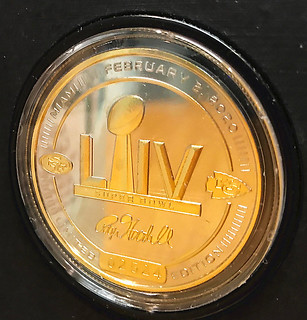 For one Melbourne company, this time of year is always some type of "toss up."
For one Melbourne company, this time of year is always some type of "toss up."
Highland Mint once again created the gold coin that will be used at the beginning of Super Bowl LIV between the Kansas City Chiefs and the San Francisco 49ers.
The referee will flip the coin to see which team gets the ball first-down in Miami.
Another coin numbered '0' is minted in case of an overtime situation.
It's the 27th year the company made the coin for the big game.
"Who would have thought the game doesn't start without us? (It) doesn't start without little old Melbourne making the coin," said Vince Bohbot, Highland Mint Executive Vice President.
Limited edition coins are sold to the public for $99.99.
Highland Mint owners say basking in the big game's spotlight keeps the 150 employees busy year-round with other pro sports licensing.
To read the complete article, see:
For 27th Year, Melbourne Company Creates Gold Coin for Super Bowl Coin Toss
(https://www.mynews13.com/fl/orlando/news/2020/01/31/melbourne-company-coin-for-super-bowl-coin-toss)
An article last year discussed the "coins" coming off the press. Check out the video. -Editor
Wednesday, the actual gold coin that will be tossed at Super Bowl 53 in Atlanta came off the mint.
Kott says the exposure Highland Mint gets from the huge spotlight of the game keeps the 150 employees busy year round, with licenses from other pro-sports and anyone wanting a personalized collectible.
"Because of this, a lot of companies find us, and we make coins for them," Kott said.
To read the complete article, see:
Central Florida Business Creates Coin to be Tossed at Super Bowl
(https://www.mynews13.com/fl/orlando/news/2019/01/24/brevard-business-creates-coin-to-be-used-in-super-bowl-53)
AUSTRALIA FIREFIGHTERS NATIONAL EMERGENCY MEDAL
Firefighters in Australia are eligible for the country's National Emergency Medal. -Editor
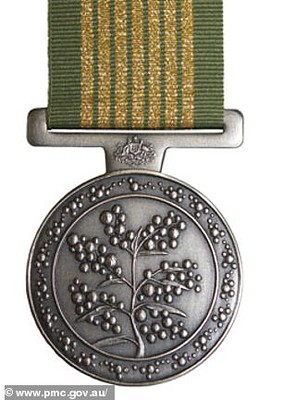 Volunteers and emergency services employees who have risked their lives battling Australia's catastrophic bushfires will be eligible to receive a National Emergency Medal.
Volunteers and emergency services employees who have risked their lives battling Australia's catastrophic bushfires will be eligible to receive a National Emergency Medal.
Recipients will join a group of 15,000 men and women who have been recognised for their efforts during previous crises in Australia.
Firefighters who have died battling blazes can be nominated posthumously.
Prime Minister Scott Morrison has also broadened the nomination criteria to include international troops who came to Australia solely to help get the infernos under control.
Mr Morrison on Australia Day said the medal would go to people who have offered 'sustained or significant service' during the crisis.
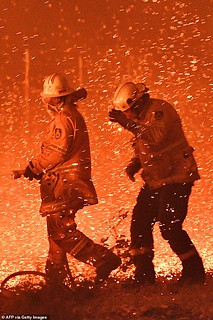 'Today as we reflect on what makes our country the best place in the world, we also honour those Australians who have battled this devastating fire season, many of whom will be on fire
grounds today protecting our communities from danger,' he said.
'Today as we reflect on what makes our country the best place in the world, we also honour those Australians who have battled this devastating fire season, many of whom will be on fire
grounds today protecting our communities from danger,' he said.
'The response to the bushfire situation has been unprecedented with thousands of volunteer and paid responders working around the clock, day and night, week after week to protect property and save lives.
Other recipients in the past have included 4470 firefighters who fought the Black Saturday bushfires in Victoria in 2009 and emergency services officers who responded to the Queensland floods and Cyclone Yasi.
To read the complete article, see:
Firefighters who have risked their lives to battle
out-of-control bushfires will be eligible for a rare medal given out to honour bravery in emergencies
(https://www.dailymail.co.uk/news/article-7929855/Australian-Bushfire-Crisis-National-Emergency-Medal-offered-firefighters.html)
NUMISMATISTS EDUCATE GOVERNMENT ON COIN VALUES
The Times of India reports that a group of numismatic experts has discovered that their government has been disposing of valuable coins for a fraction of their true market value. -Editor
The TTD may be selling demonetised and out of circulation coins to Steel Authority of India Limited based on their [face] value, while the numismatic value of these coins is several dozen times higher. Some of the coins are rare and command a price of thousands of rupees in the world numismatic market. Coin experts suggest that the TTD segregate the coins based on their antique or numismatic value and dispose of the others. TTD, which is a quasi-government body, cannot sell demonetised and out of circulation coins at a price higher than their face value, though the coins command a higher price in the numismatic market.
"A group of numismatists from the South Indian Numismatic Society led by its vice-president D Raja Reddy were engaged by the Tirumala Tirupati Devasthanams to advice it on sorting out the coins. The group spent nearly six months at TTD treasury and Parakamani wing at Tirupati. What had astonished the group was the hundi at Tirumala was receiving gold coins minted as early as 1st century CE even in the 21st century.
The group had advised the temple administration to preserve coins minted before 1947 as they carry historical significance while other voluminous coins minted after 1950s could be disposed of as per government procedures.
To read the complete article, see:
Numismatic society advises TTD to preserve antique
coins (https://timesofindia.indiatimes.com/city/vijayawada/numismatic-society-advises-ttd-to-preserve-antique-coins/articleshow/73643071.cms)
LOOSE CHANGE: FEBRUARY 2, 2020
Here are some additional items in the media this week that may be of interest. -Editor
R. W. Julian on Seated Liberty Dollars
Numismatic News published a thorough article by R. W. Julian on the history of Seated Liberty Dollars. -Editor
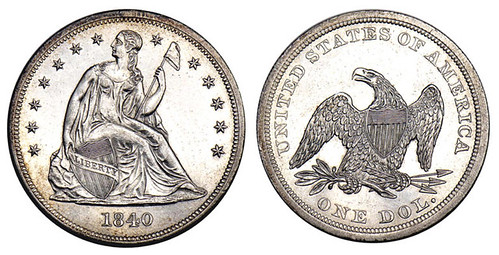
The story of the Seated Liberty motif began in June 1835 when Mint Director Samuel Moore resigned and was replaced by Dr. Robert Maskell Patterson. The new director believed that our silver coinage designs were outdated and unworthy of a great nation; to correct this situation he arranged for two talented artists, Thomas Sully and Titian Peale, to create special artwork just for a new silver dollar. Sully was given the job of designing the obverse, which was to be a seated figure of Liberty and similar to Britannia on the British coinage, yet distinctly American in character. Sully was to succeed brilliantly in his assignment; Patterson then turned over the sketches to Mint engraver Christian Gobrecht. (Peale designed the reverse with the magnificent eagle, "flying onward and upward.")
To read the complete article, see:
Seated Liberty Dollars (https://www.numismaticnews.net/article/news/seated-liberty-dollars)
Nature of France Series
A short Coin Update article by Michael Alexander examines the new Nature of France from the Monnaie de Paris. -Editor
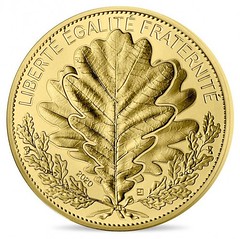
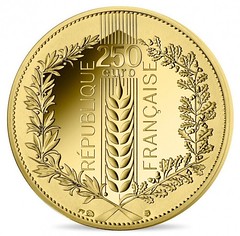
The Monnaie de Paris has launched a new three-year series that will highlight the beauty of nature through three strong numismatic symbols often depicted on French coinage: Namely the oak leaf, the laurel wreath, and the wheat sheaf. For the 2020 issue, the series concentrates on the Oak motif. Synonymous with strength and longevity, the oak is both an emotive symbol of liberty and happiness for the French Republic, and, by definition, a key numismatic element.
Designed by well-known and award-winning artist Joachim Jimenez, the obverse side depicts a very detailed oak leaf centred along with a wreath of oak leaves positioned below. The text LIBERTE EGALITE FRATERNITE is placed above the primary motif.
The reverse includes all three of the elements which will be prominently featured as part of the three-year series: A sprig of an olive branch, an oak branch, and a sheaf of wheat, which are centred. The denomination is incorporated into the design, and the text REPUBLIQUE FRANCAISE is placed on each side of the sheaf of wheat in a vertical direction.
To read the complete article, see:
France: New gold and silver coin series featuring "Nature of France" launched
(http://news.coinupdate.com/france-new-gold-and-silver-coin-series-featuring-nature-of-france-launched/)
Why Is A Company That Prints Money Running Out Of Cash?
In the great-headline department is this Forbes analysis of the financial troubles of banknote printer De Ra Rue. -Editor
But demand for cash isn’t falling at anything like the rate needed to cause such a dramatic crash. 84% of global transactions are still in cash. In the U.S., banknote production outstrips GDP growth. And in the U.K., despite predictions that by 2028 physical cash will be used in only 9% of transactions, banknote production is rising.
Nevertheless, De La Rue’s problems do seem to center on its banknote printing business, where revenues have plunged 29.5%. So if this isn’t due to declining use of cash, what is causing it?
The company’s commentary appears to suggest that there has been a one-off shock to banknote production which will eventually resolve itself. But a resilient company shouldn’t be brought to the brink of insolvency by a one-off shock. There must be something else.
And sure enough, there is. A deeper look into the company’s financials reveals a long-standing malaise.
It may be that in the future, use of cash will decline to the point where companies like De La Rue are no longer needed. But De La Rue’s present crisis is simply an old-fashioned story of too much debt, not enough equity, inadequate cash generation, and - above all - bad management.
To read the complete article, see:
Why Is A Company That Prints Money Running Out Of Cash?
(https://www.forbes.com/sites/francescoppola/2020/01/30/why-is-a-company-that-prints-money-running-out-of-cash/#7d885e8e3b5d)

